Comparative Analysis of Business Culture and Practices
VerifiedAdded on 2021/04/17
|20
|5101
|23
AI Summary
This assignment involves a comparative analysis of business culture and practices across different regions. It includes studies on cultural dimensions in European countries, market entry strategies for companies like IKEA, and consumer behavior in Asian markets. The assignment also explores the socio-economic impact of corporate social responsibility and the sustainability of Vietnamese products.
Contribute Materials
Your contribution can guide someone’s learning journey. Share your
documents today.
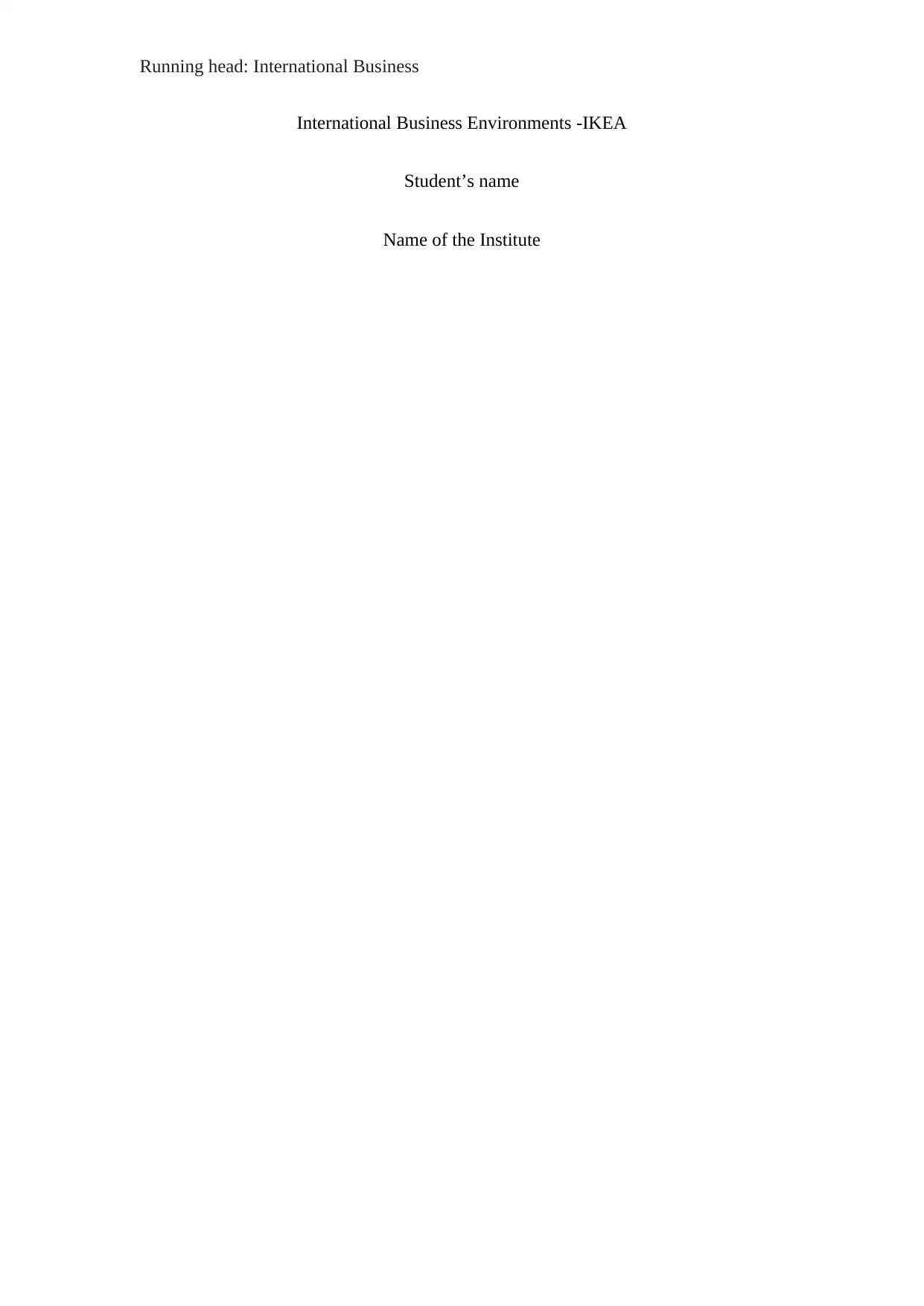
Running head: International Business
International Business Environments -IKEA
Student’s name
Name of the Institute
International Business Environments -IKEA
Student’s name
Name of the Institute
Secure Best Marks with AI Grader
Need help grading? Try our AI Grader for instant feedback on your assignments.
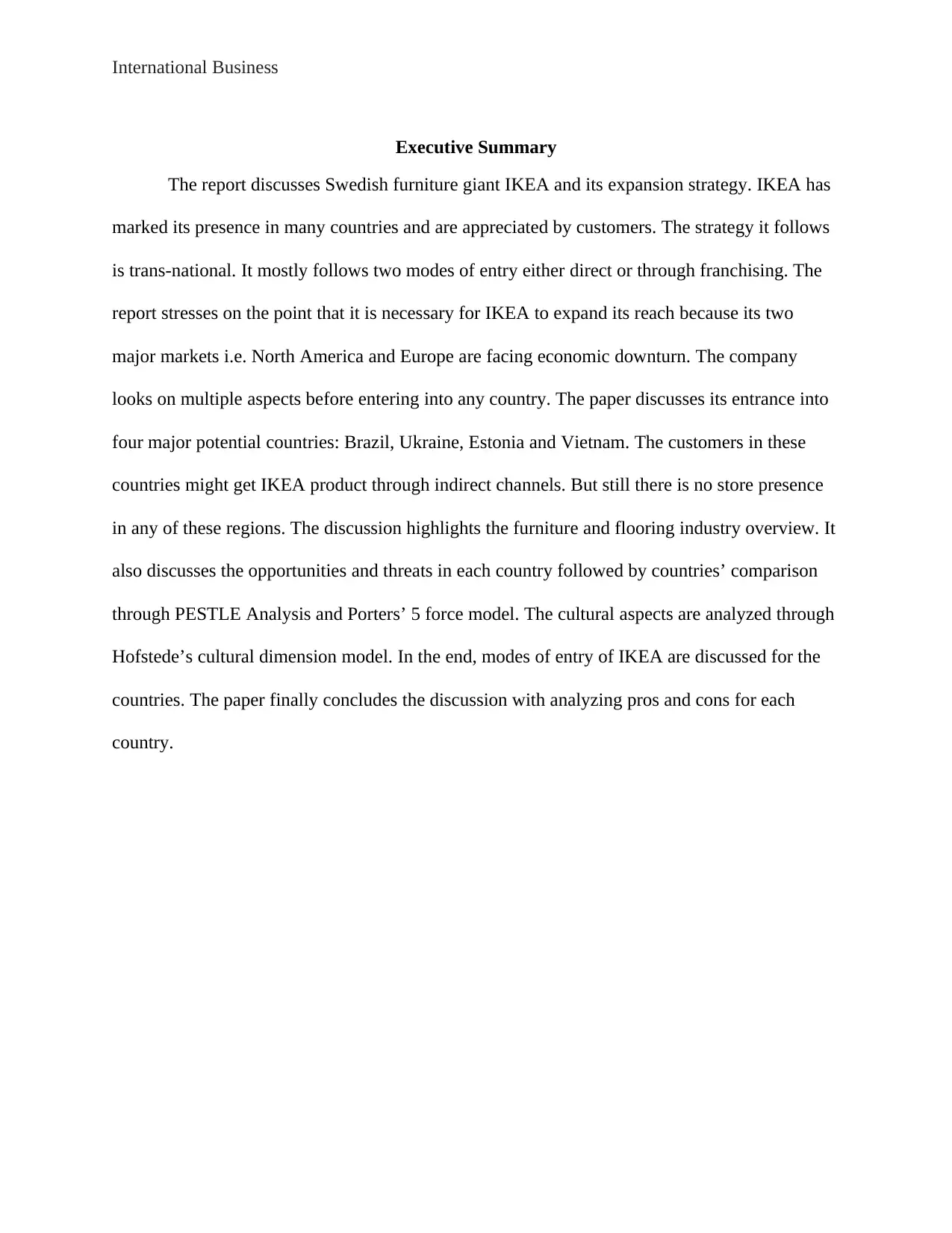
International Business
Executive Summary
The report discusses Swedish furniture giant IKEA and its expansion strategy. IKEA has
marked its presence in many countries and are appreciated by customers. The strategy it follows
is trans-national. It mostly follows two modes of entry either direct or through franchising. The
report stresses on the point that it is necessary for IKEA to expand its reach because its two
major markets i.e. North America and Europe are facing economic downturn. The company
looks on multiple aspects before entering into any country. The paper discusses its entrance into
four major potential countries: Brazil, Ukraine, Estonia and Vietnam. The customers in these
countries might get IKEA product through indirect channels. But still there is no store presence
in any of these regions. The discussion highlights the furniture and flooring industry overview. It
also discusses the opportunities and threats in each country followed by countries’ comparison
through PESTLE Analysis and Porters’ 5 force model. The cultural aspects are analyzed through
Hofstede’s cultural dimension model. In the end, modes of entry of IKEA are discussed for the
countries. The paper finally concludes the discussion with analyzing pros and cons for each
country.
Executive Summary
The report discusses Swedish furniture giant IKEA and its expansion strategy. IKEA has
marked its presence in many countries and are appreciated by customers. The strategy it follows
is trans-national. It mostly follows two modes of entry either direct or through franchising. The
report stresses on the point that it is necessary for IKEA to expand its reach because its two
major markets i.e. North America and Europe are facing economic downturn. The company
looks on multiple aspects before entering into any country. The paper discusses its entrance into
four major potential countries: Brazil, Ukraine, Estonia and Vietnam. The customers in these
countries might get IKEA product through indirect channels. But still there is no store presence
in any of these regions. The discussion highlights the furniture and flooring industry overview. It
also discusses the opportunities and threats in each country followed by countries’ comparison
through PESTLE Analysis and Porters’ 5 force model. The cultural aspects are analyzed through
Hofstede’s cultural dimension model. In the end, modes of entry of IKEA are discussed for the
countries. The paper finally concludes the discussion with analyzing pros and cons for each
country.
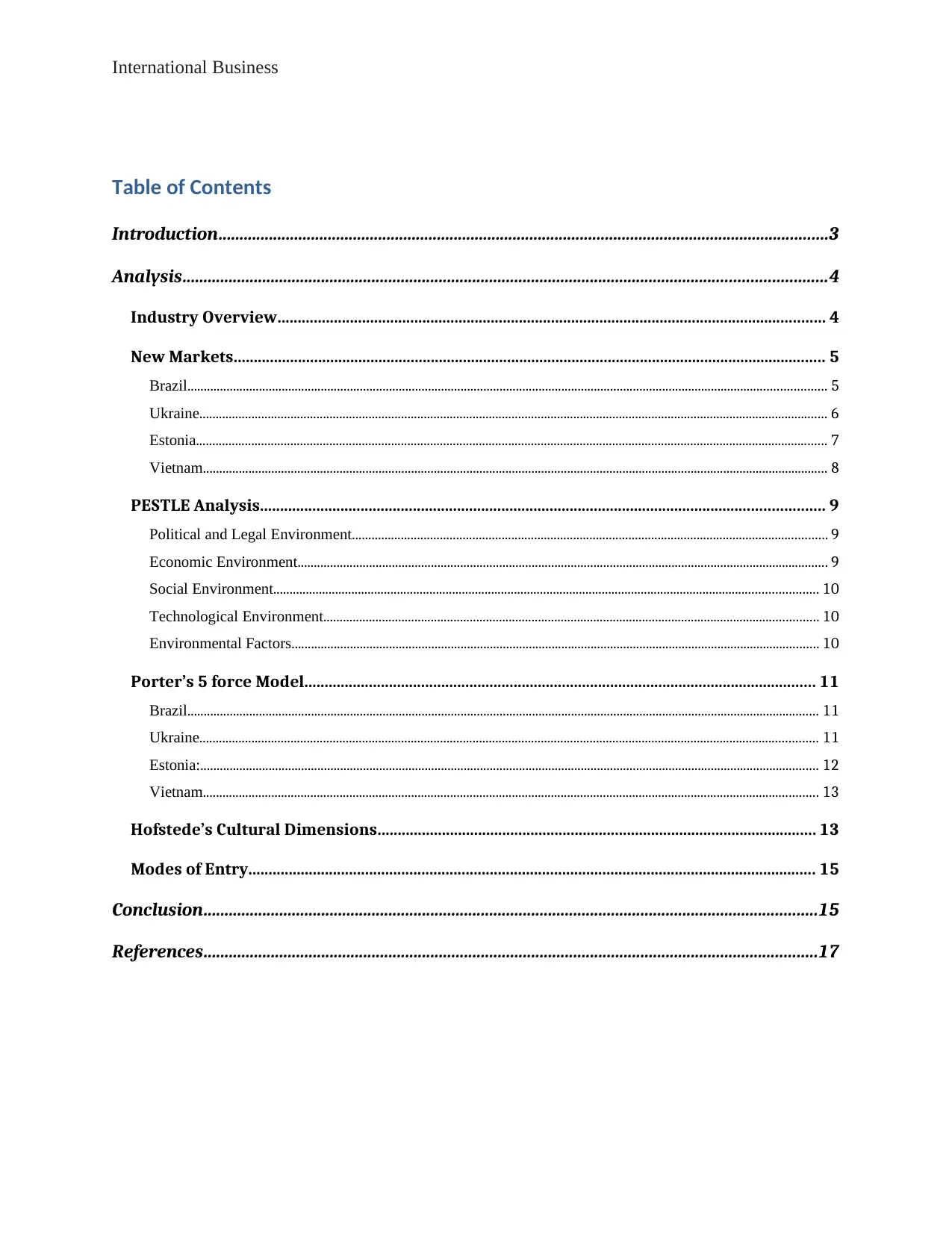
International Business
Table of Contents
Introduction.................................................................................................................................................3
Analysis.........................................................................................................................................................4
Industry Overview........................................................................................................................................ 4
New Markets................................................................................................................................................... 5
Brazil.................................................................................................................................................................................................... 5
Ukraine................................................................................................................................................................................................. 6
Estonia.................................................................................................................................................................................................. 7
Vietnam................................................................................................................................................................................................ 8
PESTLE Analysis............................................................................................................................................ 9
Political and Legal Environment.................................................................................................................................................. 9
Economic Environment................................................................................................................................................................... 9
Social Environment....................................................................................................................................................................... 10
Technological Environment........................................................................................................................................................ 10
Environmental Factors.................................................................................................................................................................. 10
Porter’s 5 force Model............................................................................................................................... 11
Brazil.................................................................................................................................................................................................. 11
Ukraine.............................................................................................................................................................................................. 11
Estonia:.............................................................................................................................................................................................. 12
Vietnam............................................................................................................................................................................................. 13
Hofstede’s Cultural Dimensions............................................................................................................. 13
Modes of Entry............................................................................................................................................. 15
Conclusion..................................................................................................................................................15
References..................................................................................................................................................17
Table of Contents
Introduction.................................................................................................................................................3
Analysis.........................................................................................................................................................4
Industry Overview........................................................................................................................................ 4
New Markets................................................................................................................................................... 5
Brazil.................................................................................................................................................................................................... 5
Ukraine................................................................................................................................................................................................. 6
Estonia.................................................................................................................................................................................................. 7
Vietnam................................................................................................................................................................................................ 8
PESTLE Analysis............................................................................................................................................ 9
Political and Legal Environment.................................................................................................................................................. 9
Economic Environment................................................................................................................................................................... 9
Social Environment....................................................................................................................................................................... 10
Technological Environment........................................................................................................................................................ 10
Environmental Factors.................................................................................................................................................................. 10
Porter’s 5 force Model............................................................................................................................... 11
Brazil.................................................................................................................................................................................................. 11
Ukraine.............................................................................................................................................................................................. 11
Estonia:.............................................................................................................................................................................................. 12
Vietnam............................................................................................................................................................................................. 13
Hofstede’s Cultural Dimensions............................................................................................................. 13
Modes of Entry............................................................................................................................................. 15
Conclusion..................................................................................................................................................15
References..................................................................................................................................................17
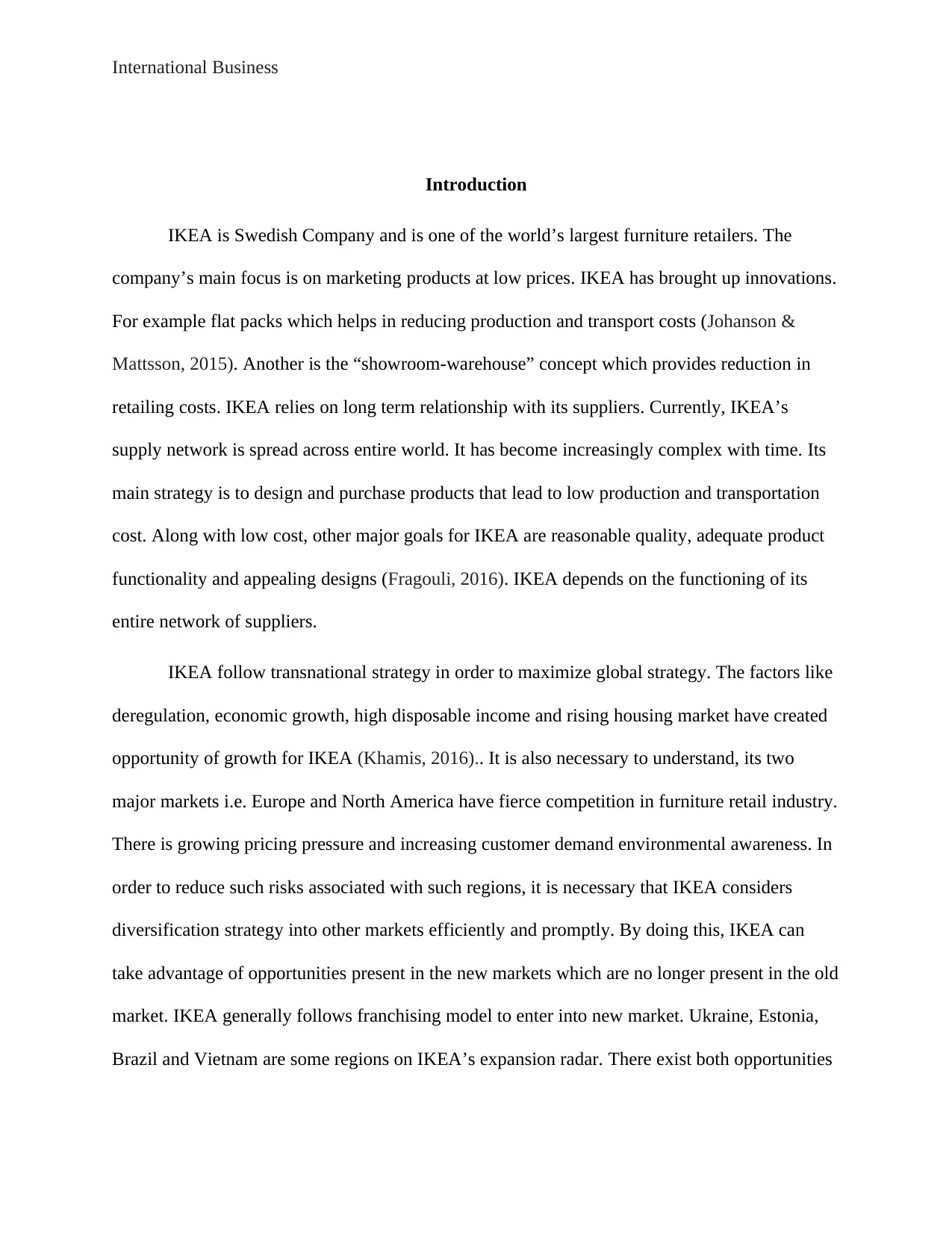
International Business
Introduction
IKEA is Swedish Company and is one of the world’s largest furniture retailers. The
company’s main focus is on marketing products at low prices. IKEA has brought up innovations.
For example flat packs which helps in reducing production and transport costs (Johanson &
Mattsson, 2015). Another is the “showroom-warehouse” concept which provides reduction in
retailing costs. IKEA relies on long term relationship with its suppliers. Currently, IKEA’s
supply network is spread across entire world. It has become increasingly complex with time. Its
main strategy is to design and purchase products that lead to low production and transportation
cost. Along with low cost, other major goals for IKEA are reasonable quality, adequate product
functionality and appealing designs (Fragouli, 2016). IKEA depends on the functioning of its
entire network of suppliers.
IKEA follow transnational strategy in order to maximize global strategy. The factors like
deregulation, economic growth, high disposable income and rising housing market have created
opportunity of growth for IKEA (Khamis, 2016).. It is also necessary to understand, its two
major markets i.e. Europe and North America have fierce competition in furniture retail industry.
There is growing pricing pressure and increasing customer demand environmental awareness. In
order to reduce such risks associated with such regions, it is necessary that IKEA considers
diversification strategy into other markets efficiently and promptly. By doing this, IKEA can
take advantage of opportunities present in the new markets which are no longer present in the old
market. IKEA generally follows franchising model to enter into new market. Ukraine, Estonia,
Brazil and Vietnam are some regions on IKEA’s expansion radar. There exist both opportunities
Introduction
IKEA is Swedish Company and is one of the world’s largest furniture retailers. The
company’s main focus is on marketing products at low prices. IKEA has brought up innovations.
For example flat packs which helps in reducing production and transport costs (Johanson &
Mattsson, 2015). Another is the “showroom-warehouse” concept which provides reduction in
retailing costs. IKEA relies on long term relationship with its suppliers. Currently, IKEA’s
supply network is spread across entire world. It has become increasingly complex with time. Its
main strategy is to design and purchase products that lead to low production and transportation
cost. Along with low cost, other major goals for IKEA are reasonable quality, adequate product
functionality and appealing designs (Fragouli, 2016). IKEA depends on the functioning of its
entire network of suppliers.
IKEA follow transnational strategy in order to maximize global strategy. The factors like
deregulation, economic growth, high disposable income and rising housing market have created
opportunity of growth for IKEA (Khamis, 2016).. It is also necessary to understand, its two
major markets i.e. Europe and North America have fierce competition in furniture retail industry.
There is growing pricing pressure and increasing customer demand environmental awareness. In
order to reduce such risks associated with such regions, it is necessary that IKEA considers
diversification strategy into other markets efficiently and promptly. By doing this, IKEA can
take advantage of opportunities present in the new markets which are no longer present in the old
market. IKEA generally follows franchising model to enter into new market. Ukraine, Estonia,
Brazil and Vietnam are some regions on IKEA’s expansion radar. There exist both opportunities
Secure Best Marks with AI Grader
Need help grading? Try our AI Grader for instant feedback on your assignments.
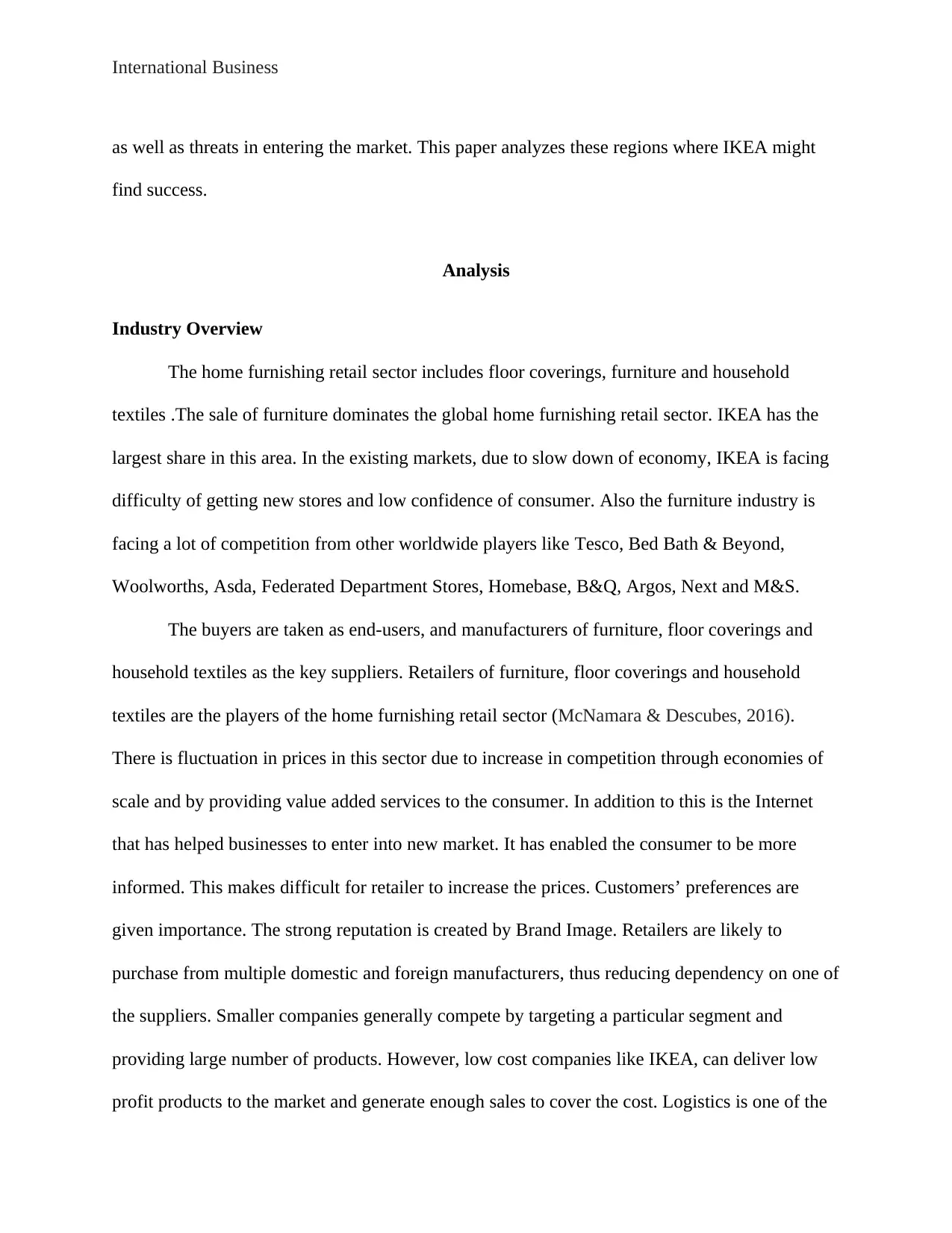
International Business
as well as threats in entering the market. This paper analyzes these regions where IKEA might
find success.
Analysis
Industry Overview
The home furnishing retail sector includes floor coverings, furniture and household
textiles .The sale of furniture dominates the global home furnishing retail sector. IKEA has the
largest share in this area. In the existing markets, due to slow down of economy, IKEA is facing
difficulty of getting new stores and low confidence of consumer. Also the furniture industry is
facing a lot of competition from other worldwide players like Tesco, Bed Bath & Beyond,
Woolworths, Asda, Federated Department Stores, Homebase, B&Q, Argos, Next and M&S.
The buyers are taken as end-users, and manufacturers of furniture, floor coverings and
household textiles as the key suppliers. Retailers of furniture, floor coverings and household
textiles are the players of the home furnishing retail sector (McNamara & Descubes, 2016).
There is fluctuation in prices in this sector due to increase in competition through economies of
scale and by providing value added services to the consumer. In addition to this is the Internet
that has helped businesses to enter into new market. It has enabled the consumer to be more
informed. This makes difficult for retailer to increase the prices. Customers’ preferences are
given importance. The strong reputation is created by Brand Image. Retailers are likely to
purchase from multiple domestic and foreign manufacturers, thus reducing dependency on one of
the suppliers. Smaller companies generally compete by targeting a particular segment and
providing large number of products. However, low cost companies like IKEA, can deliver low
profit products to the market and generate enough sales to cover the cost. Logistics is one of the
as well as threats in entering the market. This paper analyzes these regions where IKEA might
find success.
Analysis
Industry Overview
The home furnishing retail sector includes floor coverings, furniture and household
textiles .The sale of furniture dominates the global home furnishing retail sector. IKEA has the
largest share in this area. In the existing markets, due to slow down of economy, IKEA is facing
difficulty of getting new stores and low confidence of consumer. Also the furniture industry is
facing a lot of competition from other worldwide players like Tesco, Bed Bath & Beyond,
Woolworths, Asda, Federated Department Stores, Homebase, B&Q, Argos, Next and M&S.
The buyers are taken as end-users, and manufacturers of furniture, floor coverings and
household textiles as the key suppliers. Retailers of furniture, floor coverings and household
textiles are the players of the home furnishing retail sector (McNamara & Descubes, 2016).
There is fluctuation in prices in this sector due to increase in competition through economies of
scale and by providing value added services to the consumer. In addition to this is the Internet
that has helped businesses to enter into new market. It has enabled the consumer to be more
informed. This makes difficult for retailer to increase the prices. Customers’ preferences are
given importance. The strong reputation is created by Brand Image. Retailers are likely to
purchase from multiple domestic and foreign manufacturers, thus reducing dependency on one of
the suppliers. Smaller companies generally compete by targeting a particular segment and
providing large number of products. However, low cost companies like IKEA, can deliver low
profit products to the market and generate enough sales to cover the cost. Logistics is one of the
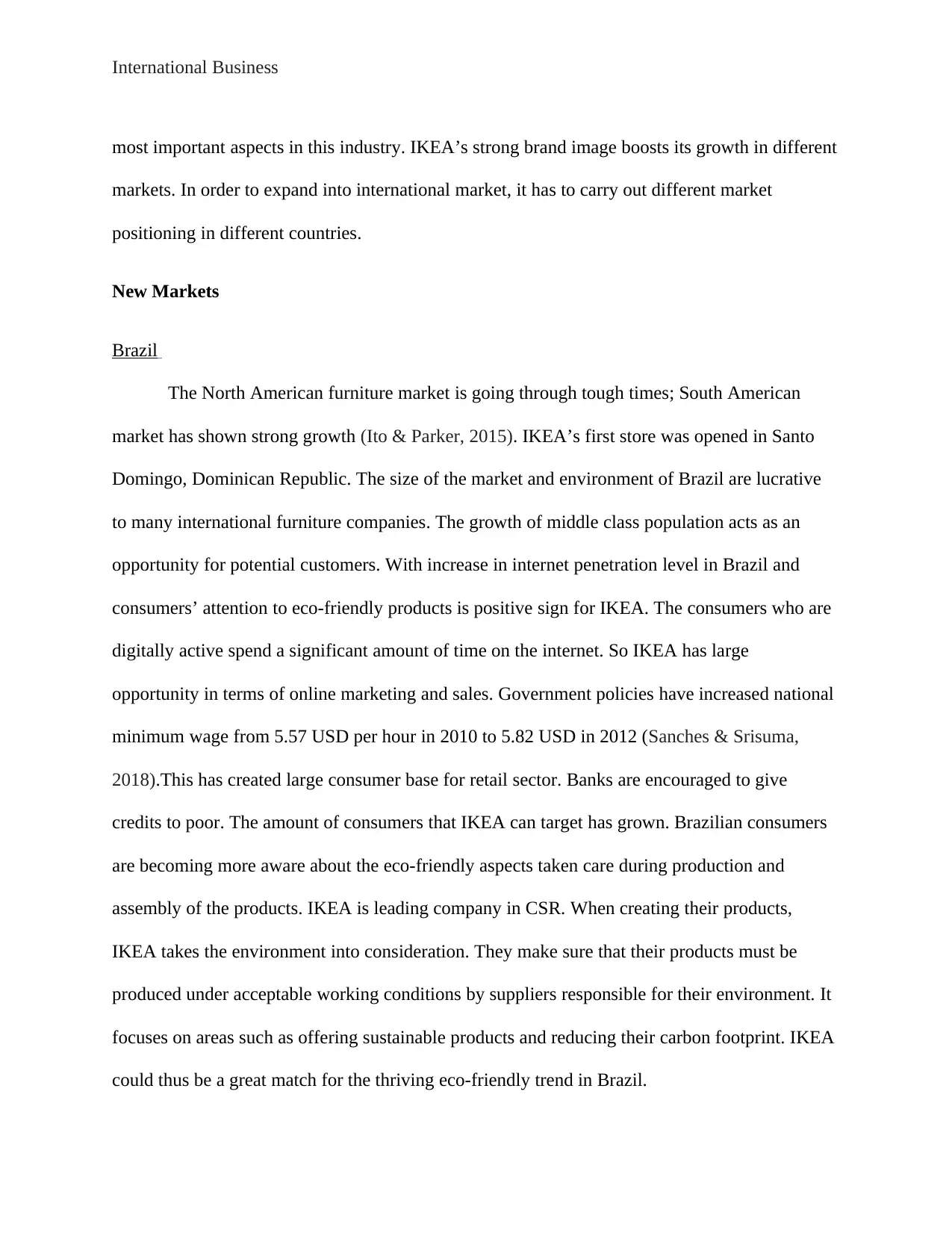
International Business
most important aspects in this industry. IKEA’s strong brand image boosts its growth in different
markets. In order to expand into international market, it has to carry out different market
positioning in different countries.
New Markets
Brazil
The North American furniture market is going through tough times; South American
market has shown strong growth (Ito & Parker, 2015). IKEA’s first store was opened in Santo
Domingo, Dominican Republic. The size of the market and environment of Brazil are lucrative
to many international furniture companies. The growth of middle class population acts as an
opportunity for potential customers. With increase in internet penetration level in Brazil and
consumers’ attention to eco-friendly products is positive sign for IKEA. The consumers who are
digitally active spend a significant amount of time on the internet. So IKEA has large
opportunity in terms of online marketing and sales. Government policies have increased national
minimum wage from 5.57 USD per hour in 2010 to 5.82 USD in 2012 (Sanches & Srisuma,
2018).This has created large consumer base for retail sector. Banks are encouraged to give
credits to poor. The amount of consumers that IKEA can target has grown. Brazilian consumers
are becoming more aware about the eco-friendly aspects taken care during production and
assembly of the products. IKEA is leading company in CSR. When creating their products,
IKEA takes the environment into consideration. They make sure that their products must be
produced under acceptable working conditions by suppliers responsible for their environment. It
focuses on areas such as offering sustainable products and reducing their carbon footprint. IKEA
could thus be a great match for the thriving eco-friendly trend in Brazil.
most important aspects in this industry. IKEA’s strong brand image boosts its growth in different
markets. In order to expand into international market, it has to carry out different market
positioning in different countries.
New Markets
Brazil
The North American furniture market is going through tough times; South American
market has shown strong growth (Ito & Parker, 2015). IKEA’s first store was opened in Santo
Domingo, Dominican Republic. The size of the market and environment of Brazil are lucrative
to many international furniture companies. The growth of middle class population acts as an
opportunity for potential customers. With increase in internet penetration level in Brazil and
consumers’ attention to eco-friendly products is positive sign for IKEA. The consumers who are
digitally active spend a significant amount of time on the internet. So IKEA has large
opportunity in terms of online marketing and sales. Government policies have increased national
minimum wage from 5.57 USD per hour in 2010 to 5.82 USD in 2012 (Sanches & Srisuma,
2018).This has created large consumer base for retail sector. Banks are encouraged to give
credits to poor. The amount of consumers that IKEA can target has grown. Brazilian consumers
are becoming more aware about the eco-friendly aspects taken care during production and
assembly of the products. IKEA is leading company in CSR. When creating their products,
IKEA takes the environment into consideration. They make sure that their products must be
produced under acceptable working conditions by suppliers responsible for their environment. It
focuses on areas such as offering sustainable products and reducing their carbon footprint. IKEA
could thus be a great match for the thriving eco-friendly trend in Brazil.
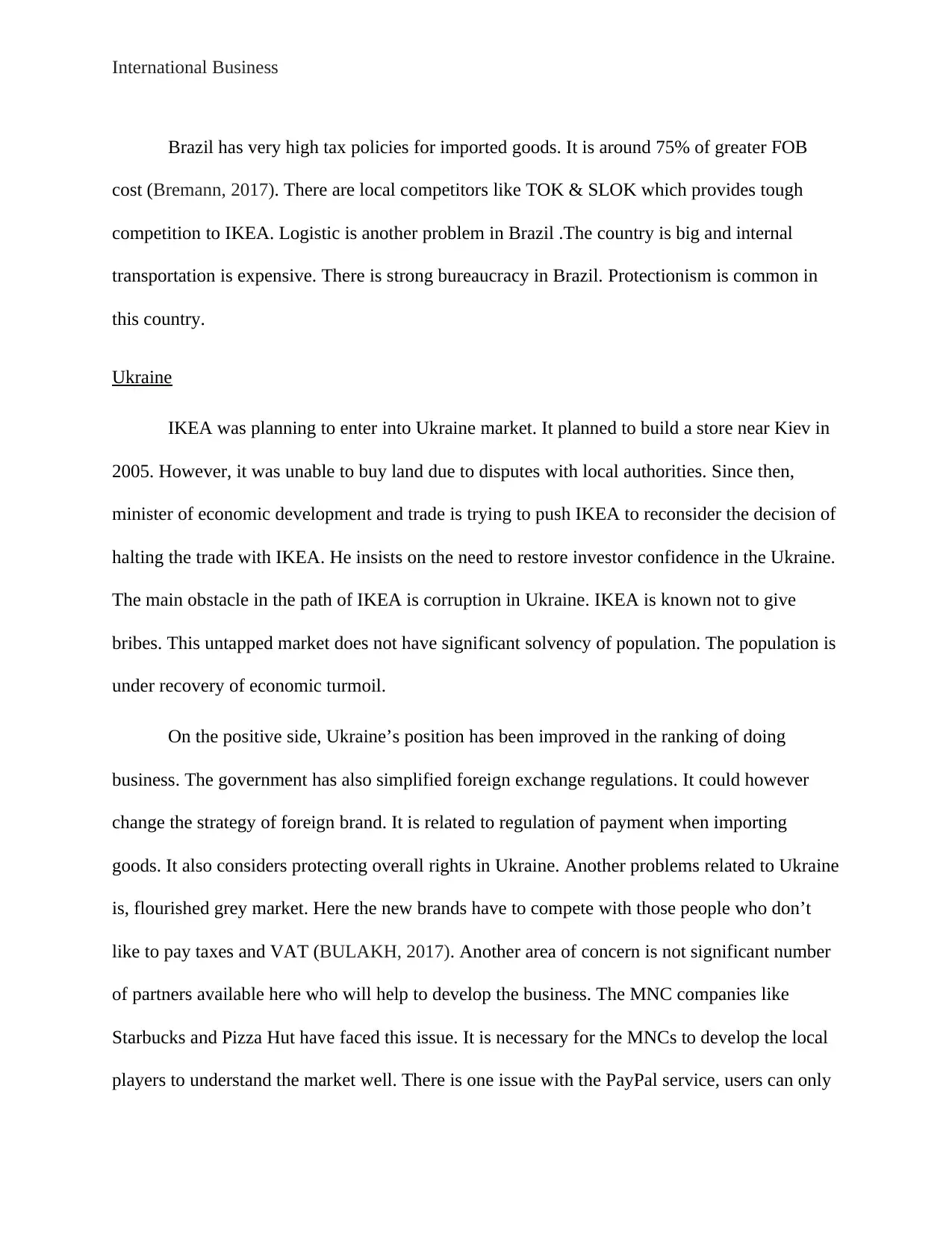
International Business
Brazil has very high tax policies for imported goods. It is around 75% of greater FOB
cost (Bremann, 2017). There are local competitors like TOK & SLOK which provides tough
competition to IKEA. Logistic is another problem in Brazil .The country is big and internal
transportation is expensive. There is strong bureaucracy in Brazil. Protectionism is common in
this country.
Ukraine
IKEA was planning to enter into Ukraine market. It planned to build a store near Kiev in
2005. However, it was unable to buy land due to disputes with local authorities. Since then,
minister of economic development and trade is trying to push IKEA to reconsider the decision of
halting the trade with IKEA. He insists on the need to restore investor confidence in the Ukraine.
The main obstacle in the path of IKEA is corruption in Ukraine. IKEA is known not to give
bribes. This untapped market does not have significant solvency of population. The population is
under recovery of economic turmoil.
On the positive side, Ukraine’s position has been improved in the ranking of doing
business. The government has also simplified foreign exchange regulations. It could however
change the strategy of foreign brand. It is related to regulation of payment when importing
goods. It also considers protecting overall rights in Ukraine. Another problems related to Ukraine
is, flourished grey market. Here the new brands have to compete with those people who don’t
like to pay taxes and VAT (BULAKH, 2017). Another area of concern is not significant number
of partners available here who will help to develop the business. The MNC companies like
Starbucks and Pizza Hut have faced this issue. It is necessary for the MNCs to develop the local
players to understand the market well. There is one issue with the PayPal service, users can only
Brazil has very high tax policies for imported goods. It is around 75% of greater FOB
cost (Bremann, 2017). There are local competitors like TOK & SLOK which provides tough
competition to IKEA. Logistic is another problem in Brazil .The country is big and internal
transportation is expensive. There is strong bureaucracy in Brazil. Protectionism is common in
this country.
Ukraine
IKEA was planning to enter into Ukraine market. It planned to build a store near Kiev in
2005. However, it was unable to buy land due to disputes with local authorities. Since then,
minister of economic development and trade is trying to push IKEA to reconsider the decision of
halting the trade with IKEA. He insists on the need to restore investor confidence in the Ukraine.
The main obstacle in the path of IKEA is corruption in Ukraine. IKEA is known not to give
bribes. This untapped market does not have significant solvency of population. The population is
under recovery of economic turmoil.
On the positive side, Ukraine’s position has been improved in the ranking of doing
business. The government has also simplified foreign exchange regulations. It could however
change the strategy of foreign brand. It is related to regulation of payment when importing
goods. It also considers protecting overall rights in Ukraine. Another problems related to Ukraine
is, flourished grey market. Here the new brands have to compete with those people who don’t
like to pay taxes and VAT (BULAKH, 2017). Another area of concern is not significant number
of partners available here who will help to develop the business. The MNC companies like
Starbucks and Pizza Hut have faced this issue. It is necessary for the MNCs to develop the local
players to understand the market well. There is one issue with the PayPal service, users can only
Paraphrase This Document
Need a fresh take? Get an instant paraphrase of this document with our AI Paraphraser
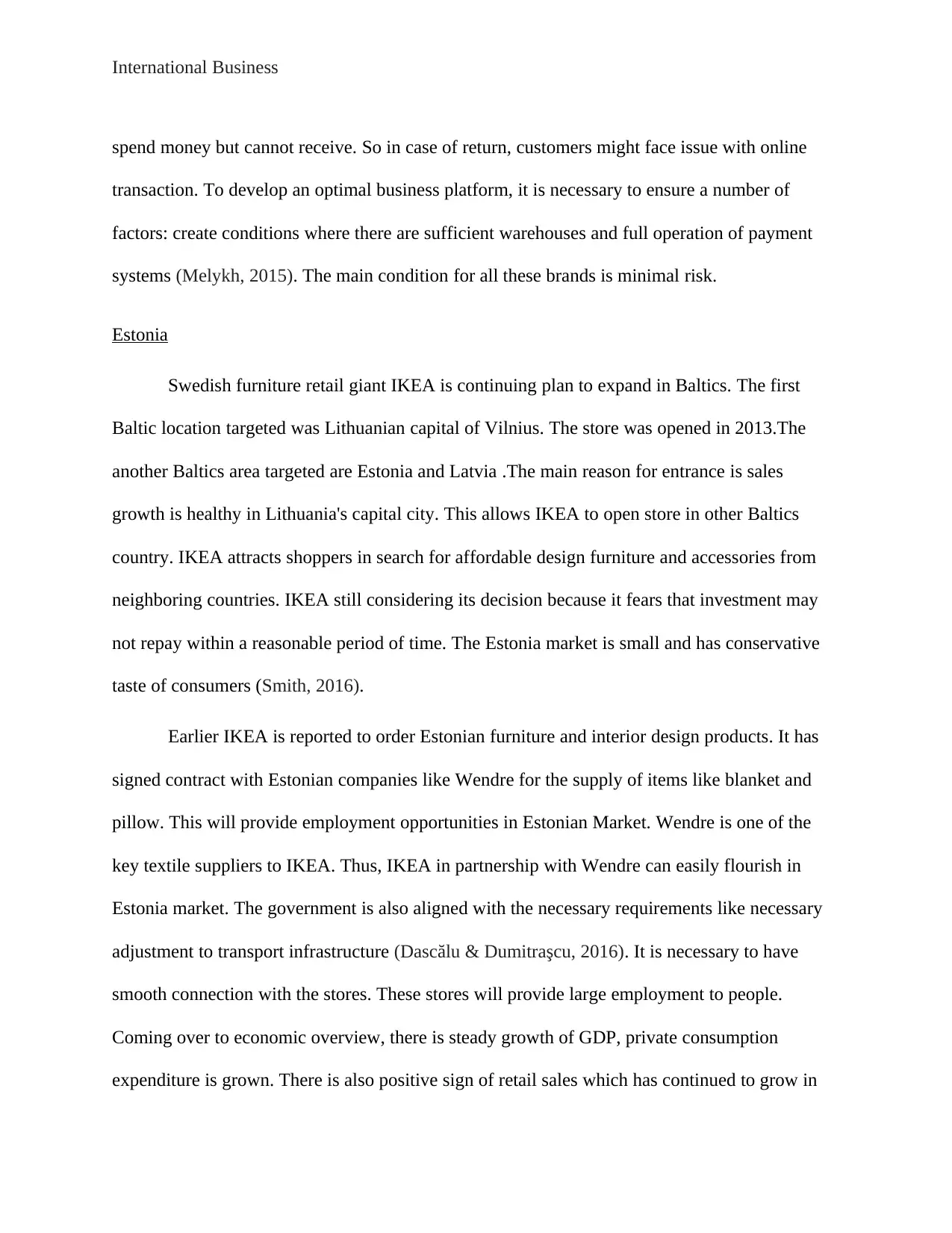
International Business
spend money but cannot receive. So in case of return, customers might face issue with online
transaction. To develop an optimal business platform, it is necessary to ensure a number of
factors: create conditions where there are sufficient warehouses and full operation of payment
systems (Melykh, 2015). The main condition for all these brands is minimal risk.
Estonia
Swedish furniture retail giant IKEA is continuing plan to expand in Baltics. The first
Baltic location targeted was Lithuanian capital of Vilnius. The store was opened in 2013.The
another Baltics area targeted are Estonia and Latvia .The main reason for entrance is sales
growth is healthy in Lithuania's capital city. This allows IKEA to open store in other Baltics
country. IKEA attracts shoppers in search for affordable design furniture and accessories from
neighboring countries. IKEA still considering its decision because it fears that investment may
not repay within a reasonable period of time. The Estonia market is small and has conservative
taste of consumers (Smith, 2016).
Earlier IKEA is reported to order Estonian furniture and interior design products. It has
signed contract with Estonian companies like Wendre for the supply of items like blanket and
pillow. This will provide employment opportunities in Estonian Market. Wendre is one of the
key textile suppliers to IKEA. Thus, IKEA in partnership with Wendre can easily flourish in
Estonia market. The government is also aligned with the necessary requirements like necessary
adjustment to transport infrastructure (Dascălu & Dumitraşcu, 2016). It is necessary to have
smooth connection with the stores. These stores will provide large employment to people.
Coming over to economic overview, there is steady growth of GDP, private consumption
expenditure is grown. There is also positive sign of retail sales which has continued to grow in
spend money but cannot receive. So in case of return, customers might face issue with online
transaction. To develop an optimal business platform, it is necessary to ensure a number of
factors: create conditions where there are sufficient warehouses and full operation of payment
systems (Melykh, 2015). The main condition for all these brands is minimal risk.
Estonia
Swedish furniture retail giant IKEA is continuing plan to expand in Baltics. The first
Baltic location targeted was Lithuanian capital of Vilnius. The store was opened in 2013.The
another Baltics area targeted are Estonia and Latvia .The main reason for entrance is sales
growth is healthy in Lithuania's capital city. This allows IKEA to open store in other Baltics
country. IKEA attracts shoppers in search for affordable design furniture and accessories from
neighboring countries. IKEA still considering its decision because it fears that investment may
not repay within a reasonable period of time. The Estonia market is small and has conservative
taste of consumers (Smith, 2016).
Earlier IKEA is reported to order Estonian furniture and interior design products. It has
signed contract with Estonian companies like Wendre for the supply of items like blanket and
pillow. This will provide employment opportunities in Estonian Market. Wendre is one of the
key textile suppliers to IKEA. Thus, IKEA in partnership with Wendre can easily flourish in
Estonia market. The government is also aligned with the necessary requirements like necessary
adjustment to transport infrastructure (Dascălu & Dumitraşcu, 2016). It is necessary to have
smooth connection with the stores. These stores will provide large employment to people.
Coming over to economic overview, there is steady growth of GDP, private consumption
expenditure is grown. There is also positive sign of retail sales which has continued to grow in
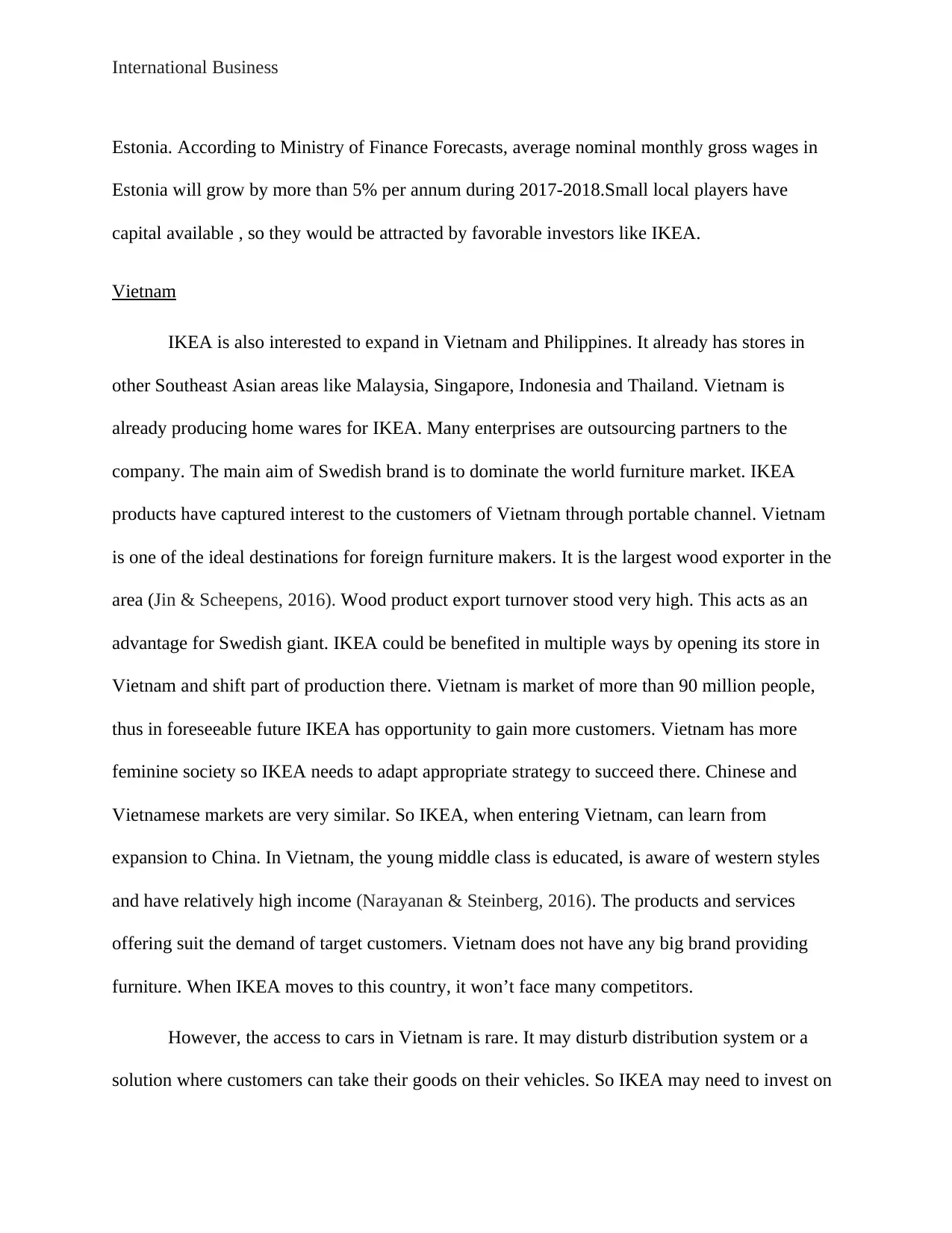
International Business
Estonia. According to Ministry of Finance Forecasts, average nominal monthly gross wages in
Estonia will grow by more than 5% per annum during 2017-2018.Small local players have
capital available , so they would be attracted by favorable investors like IKEA.
Vietnam
IKEA is also interested to expand in Vietnam and Philippines. It already has stores in
other Southeast Asian areas like Malaysia, Singapore, Indonesia and Thailand. Vietnam is
already producing home wares for IKEA. Many enterprises are outsourcing partners to the
company. The main aim of Swedish brand is to dominate the world furniture market. IKEA
products have captured interest to the customers of Vietnam through portable channel. Vietnam
is one of the ideal destinations for foreign furniture makers. It is the largest wood exporter in the
area (Jin & Scheepens, 2016). Wood product export turnover stood very high. This acts as an
advantage for Swedish giant. IKEA could be benefited in multiple ways by opening its store in
Vietnam and shift part of production there. Vietnam is market of more than 90 million people,
thus in foreseeable future IKEA has opportunity to gain more customers. Vietnam has more
feminine society so IKEA needs to adapt appropriate strategy to succeed there. Chinese and
Vietnamese markets are very similar. So IKEA, when entering Vietnam, can learn from
expansion to China. In Vietnam, the young middle class is educated, is aware of western styles
and have relatively high income (Narayanan & Steinberg, 2016). The products and services
offering suit the demand of target customers. Vietnam does not have any big brand providing
furniture. When IKEA moves to this country, it won’t face many competitors.
However, the access to cars in Vietnam is rare. It may disturb distribution system or a
solution where customers can take their goods on their vehicles. So IKEA may need to invest on
Estonia. According to Ministry of Finance Forecasts, average nominal monthly gross wages in
Estonia will grow by more than 5% per annum during 2017-2018.Small local players have
capital available , so they would be attracted by favorable investors like IKEA.
Vietnam
IKEA is also interested to expand in Vietnam and Philippines. It already has stores in
other Southeast Asian areas like Malaysia, Singapore, Indonesia and Thailand. Vietnam is
already producing home wares for IKEA. Many enterprises are outsourcing partners to the
company. The main aim of Swedish brand is to dominate the world furniture market. IKEA
products have captured interest to the customers of Vietnam through portable channel. Vietnam
is one of the ideal destinations for foreign furniture makers. It is the largest wood exporter in the
area (Jin & Scheepens, 2016). Wood product export turnover stood very high. This acts as an
advantage for Swedish giant. IKEA could be benefited in multiple ways by opening its store in
Vietnam and shift part of production there. Vietnam is market of more than 90 million people,
thus in foreseeable future IKEA has opportunity to gain more customers. Vietnam has more
feminine society so IKEA needs to adapt appropriate strategy to succeed there. Chinese and
Vietnamese markets are very similar. So IKEA, when entering Vietnam, can learn from
expansion to China. In Vietnam, the young middle class is educated, is aware of western styles
and have relatively high income (Narayanan & Steinberg, 2016). The products and services
offering suit the demand of target customers. Vietnam does not have any big brand providing
furniture. When IKEA moves to this country, it won’t face many competitors.
However, the access to cars in Vietnam is rare. It may disturb distribution system or a
solution where customers can take their goods on their vehicles. So IKEA may need to invest on
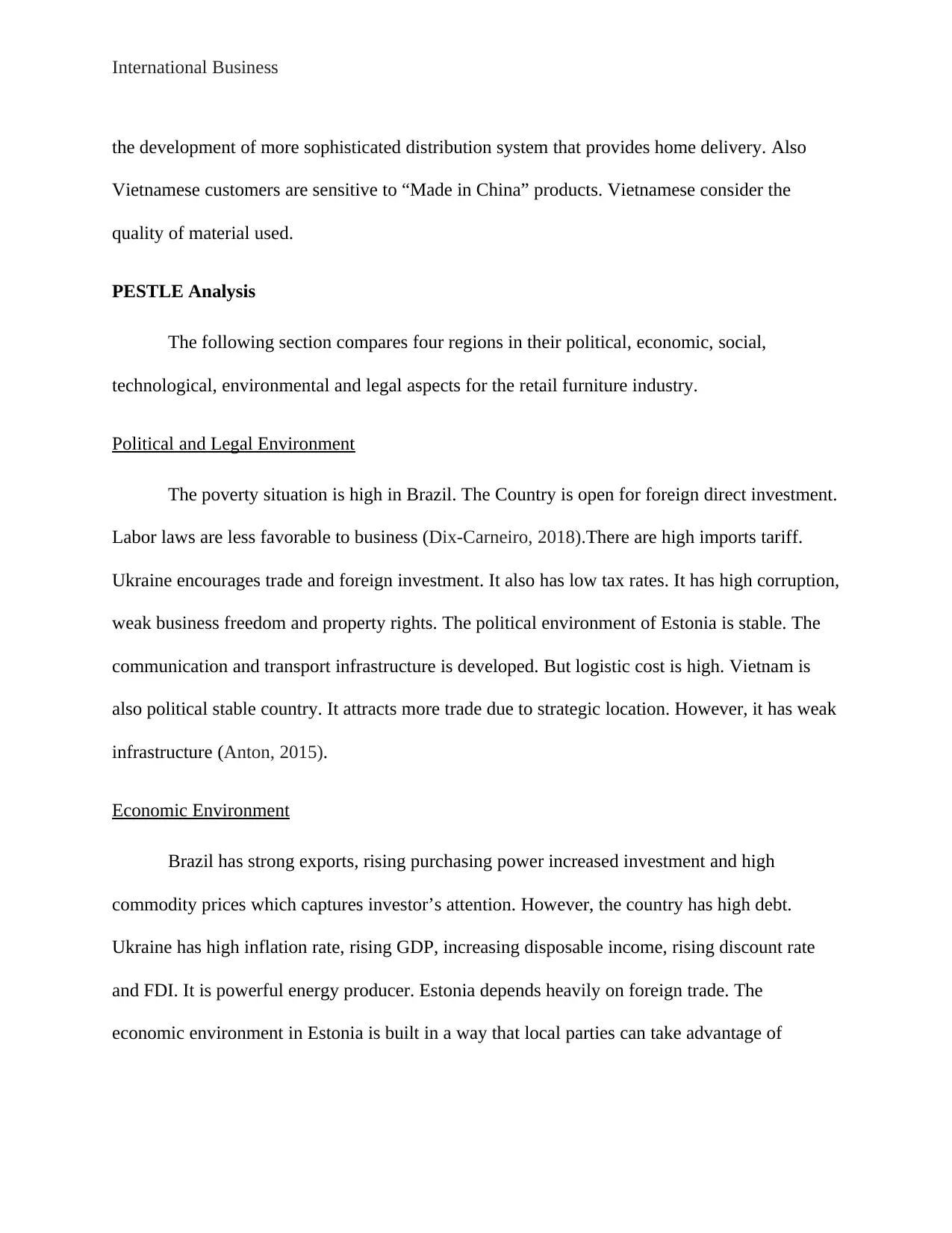
International Business
the development of more sophisticated distribution system that provides home delivery. Also
Vietnamese customers are sensitive to “Made in China” products. Vietnamese consider the
quality of material used.
PESTLE Analysis
The following section compares four regions in their political, economic, social,
technological, environmental and legal aspects for the retail furniture industry.
Political and Legal Environment
The poverty situation is high in Brazil. The Country is open for foreign direct investment.
Labor laws are less favorable to business (Dix-Carneiro, 2018).There are high imports tariff.
Ukraine encourages trade and foreign investment. It also has low tax rates. It has high corruption,
weak business freedom and property rights. The political environment of Estonia is stable. The
communication and transport infrastructure is developed. But logistic cost is high. Vietnam is
also political stable country. It attracts more trade due to strategic location. However, it has weak
infrastructure (Anton, 2015).
Economic Environment
Brazil has strong exports, rising purchasing power increased investment and high
commodity prices which captures investor’s attention. However, the country has high debt.
Ukraine has high inflation rate, rising GDP, increasing disposable income, rising discount rate
and FDI. It is powerful energy producer. Estonia depends heavily on foreign trade. The
economic environment in Estonia is built in a way that local parties can take advantage of
the development of more sophisticated distribution system that provides home delivery. Also
Vietnamese customers are sensitive to “Made in China” products. Vietnamese consider the
quality of material used.
PESTLE Analysis
The following section compares four regions in their political, economic, social,
technological, environmental and legal aspects for the retail furniture industry.
Political and Legal Environment
The poverty situation is high in Brazil. The Country is open for foreign direct investment.
Labor laws are less favorable to business (Dix-Carneiro, 2018).There are high imports tariff.
Ukraine encourages trade and foreign investment. It also has low tax rates. It has high corruption,
weak business freedom and property rights. The political environment of Estonia is stable. The
communication and transport infrastructure is developed. But logistic cost is high. Vietnam is
also political stable country. It attracts more trade due to strategic location. However, it has weak
infrastructure (Anton, 2015).
Economic Environment
Brazil has strong exports, rising purchasing power increased investment and high
commodity prices which captures investor’s attention. However, the country has high debt.
Ukraine has high inflation rate, rising GDP, increasing disposable income, rising discount rate
and FDI. It is powerful energy producer. Estonia depends heavily on foreign trade. The
economic environment in Estonia is built in a way that local parties can take advantage of
Secure Best Marks with AI Grader
Need help grading? Try our AI Grader for instant feedback on your assignments.
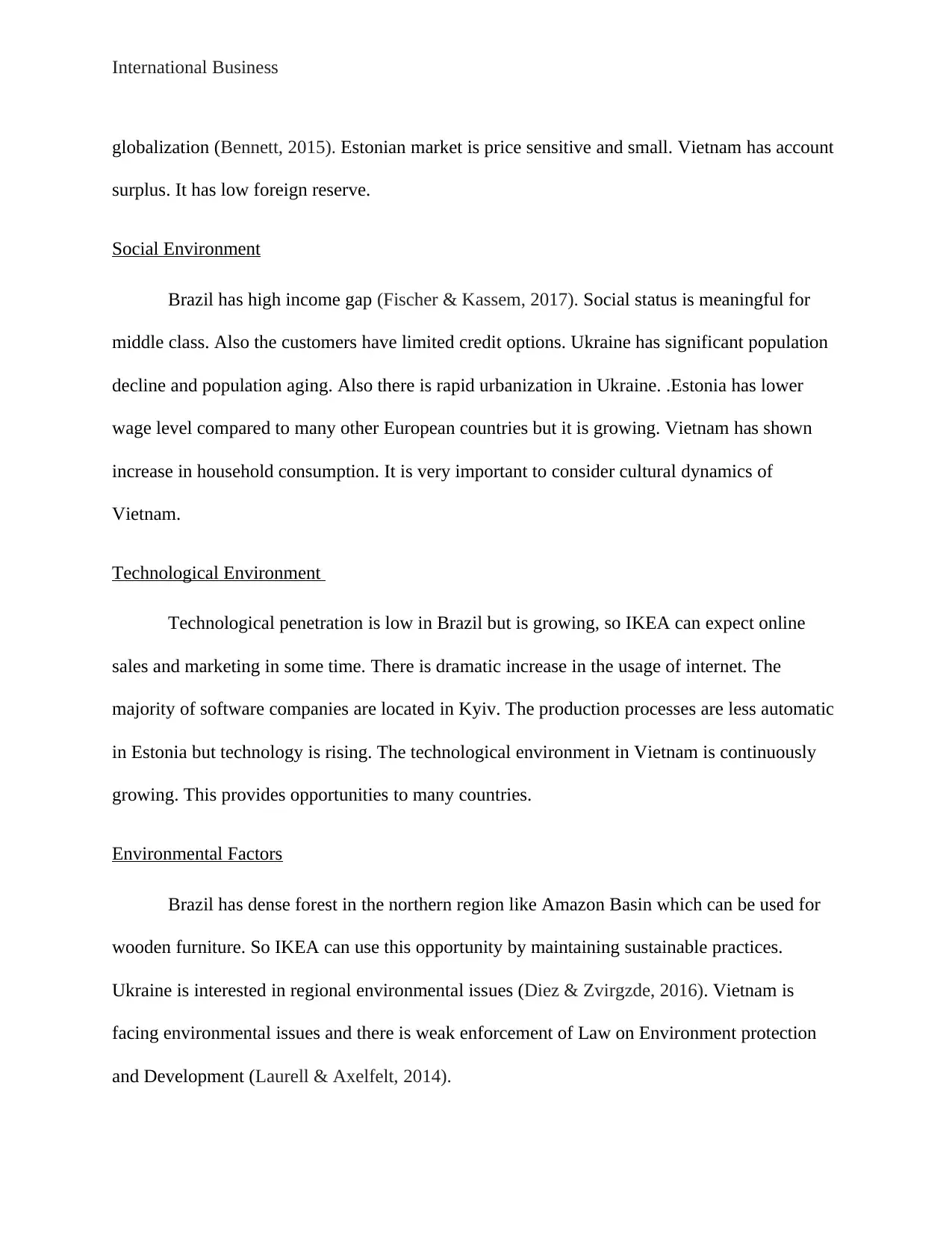
International Business
globalization (Bennett, 2015). Estonian market is price sensitive and small. Vietnam has account
surplus. It has low foreign reserve.
Social Environment
Brazil has high income gap (Fischer & Kassem, 2017). Social status is meaningful for
middle class. Also the customers have limited credit options. Ukraine has significant population
decline and population aging. Also there is rapid urbanization in Ukraine. .Estonia has lower
wage level compared to many other European countries but it is growing. Vietnam has shown
increase in household consumption. It is very important to consider cultural dynamics of
Vietnam.
Technological Environment
Technological penetration is low in Brazil but is growing, so IKEA can expect online
sales and marketing in some time. There is dramatic increase in the usage of internet. The
majority of software companies are located in Kyiv. The production processes are less automatic
in Estonia but technology is rising. The technological environment in Vietnam is continuously
growing. This provides opportunities to many countries.
Environmental Factors
Brazil has dense forest in the northern region like Amazon Basin which can be used for
wooden furniture. So IKEA can use this opportunity by maintaining sustainable practices.
Ukraine is interested in regional environmental issues (Diez & Zvirgzde, 2016). Vietnam is
facing environmental issues and there is weak enforcement of Law on Environment protection
and Development (Laurell & Axelfelt, 2014).
globalization (Bennett, 2015). Estonian market is price sensitive and small. Vietnam has account
surplus. It has low foreign reserve.
Social Environment
Brazil has high income gap (Fischer & Kassem, 2017). Social status is meaningful for
middle class. Also the customers have limited credit options. Ukraine has significant population
decline and population aging. Also there is rapid urbanization in Ukraine. .Estonia has lower
wage level compared to many other European countries but it is growing. Vietnam has shown
increase in household consumption. It is very important to consider cultural dynamics of
Vietnam.
Technological Environment
Technological penetration is low in Brazil but is growing, so IKEA can expect online
sales and marketing in some time. There is dramatic increase in the usage of internet. The
majority of software companies are located in Kyiv. The production processes are less automatic
in Estonia but technology is rising. The technological environment in Vietnam is continuously
growing. This provides opportunities to many countries.
Environmental Factors
Brazil has dense forest in the northern region like Amazon Basin which can be used for
wooden furniture. So IKEA can use this opportunity by maintaining sustainable practices.
Ukraine is interested in regional environmental issues (Diez & Zvirgzde, 2016). Vietnam is
facing environmental issues and there is weak enforcement of Law on Environment protection
and Development (Laurell & Axelfelt, 2014).
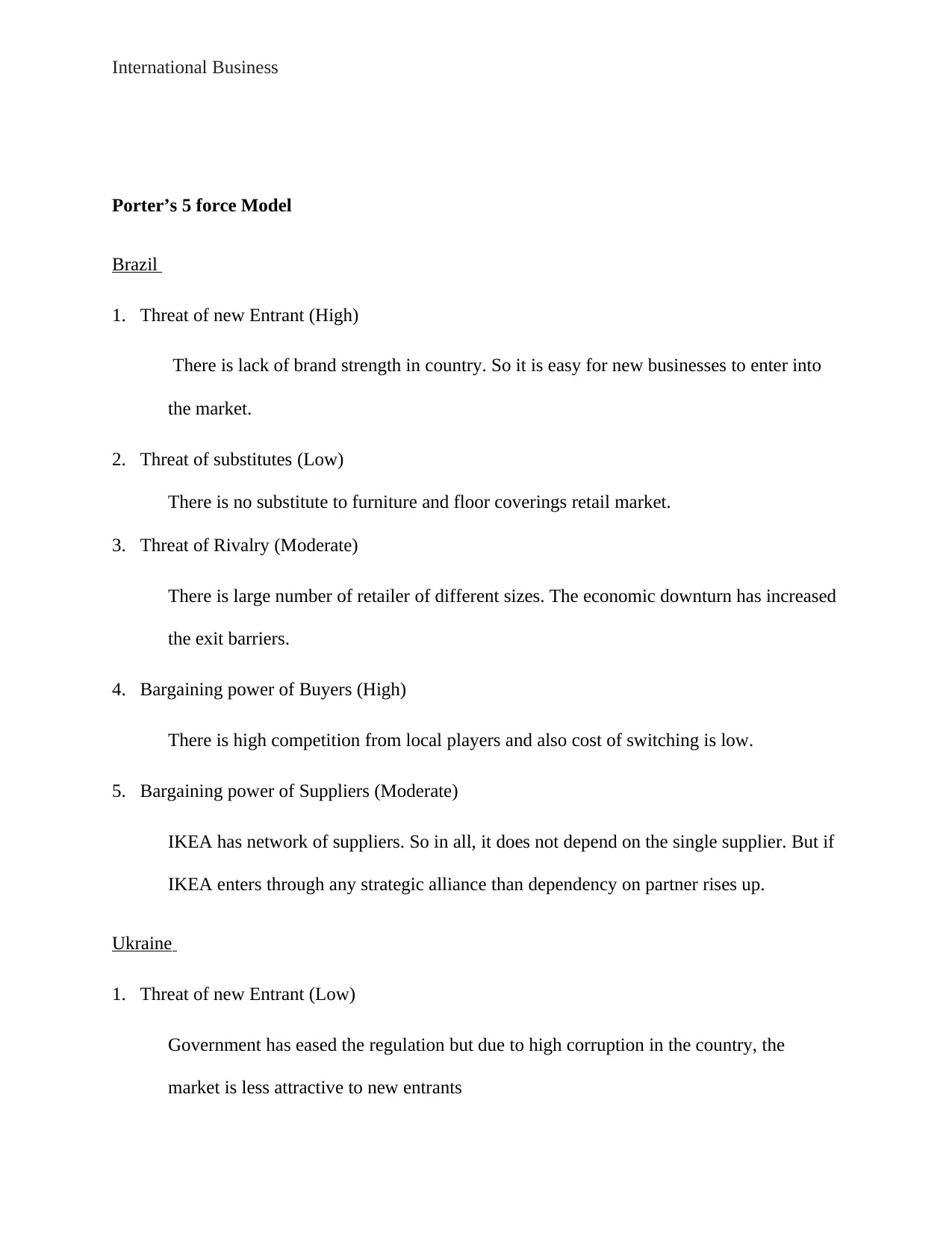
International Business
Porter’s 5 force Model
Brazil
1. Threat of new Entrant (High)
There is lack of brand strength in country. So it is easy for new businesses to enter into
the market.
2. Threat of substitutes (Low)
There is no substitute to furniture and floor coverings retail market.
3. Threat of Rivalry (Moderate)
There is large number of retailer of different sizes. The economic downturn has increased
the exit barriers.
4. Bargaining power of Buyers (High)
There is high competition from local players and also cost of switching is low.
5. Bargaining power of Suppliers (Moderate)
IKEA has network of suppliers. So in all, it does not depend on the single supplier. But if
IKEA enters through any strategic alliance than dependency on partner rises up.
Ukraine
1. Threat of new Entrant (Low)
Government has eased the regulation but due to high corruption in the country, the
market is less attractive to new entrants
Porter’s 5 force Model
Brazil
1. Threat of new Entrant (High)
There is lack of brand strength in country. So it is easy for new businesses to enter into
the market.
2. Threat of substitutes (Low)
There is no substitute to furniture and floor coverings retail market.
3. Threat of Rivalry (Moderate)
There is large number of retailer of different sizes. The economic downturn has increased
the exit barriers.
4. Bargaining power of Buyers (High)
There is high competition from local players and also cost of switching is low.
5. Bargaining power of Suppliers (Moderate)
IKEA has network of suppliers. So in all, it does not depend on the single supplier. But if
IKEA enters through any strategic alliance than dependency on partner rises up.
Ukraine
1. Threat of new Entrant (Low)
Government has eased the regulation but due to high corruption in the country, the
market is less attractive to new entrants
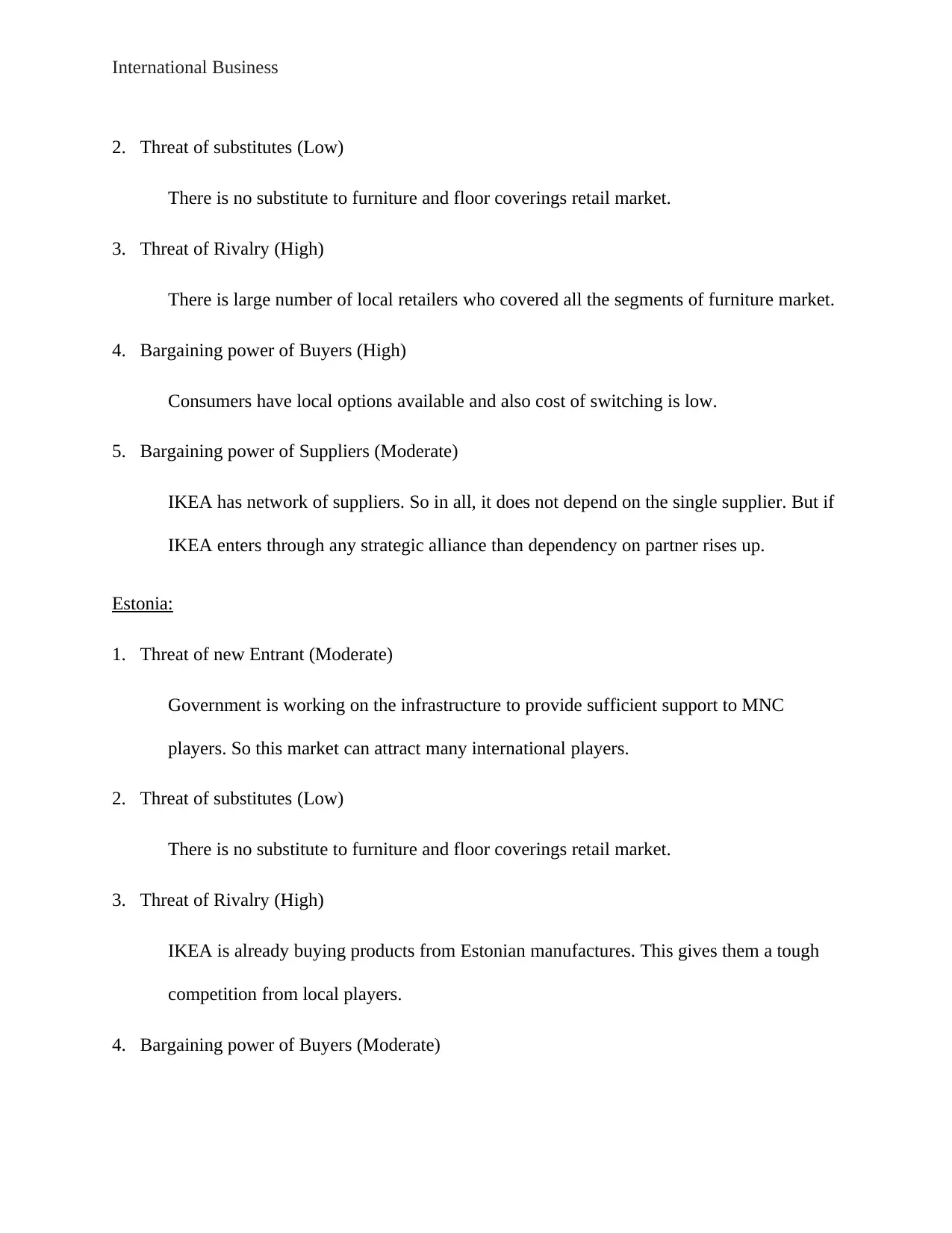
International Business
2. Threat of substitutes (Low)
There is no substitute to furniture and floor coverings retail market.
3. Threat of Rivalry (High)
There is large number of local retailers who covered all the segments of furniture market.
4. Bargaining power of Buyers (High)
Consumers have local options available and also cost of switching is low.
5. Bargaining power of Suppliers (Moderate)
IKEA has network of suppliers. So in all, it does not depend on the single supplier. But if
IKEA enters through any strategic alliance than dependency on partner rises up.
Estonia:
1. Threat of new Entrant (Moderate)
Government is working on the infrastructure to provide sufficient support to MNC
players. So this market can attract many international players.
2. Threat of substitutes (Low)
There is no substitute to furniture and floor coverings retail market.
3. Threat of Rivalry (High)
IKEA is already buying products from Estonian manufactures. This gives them a tough
competition from local players.
4. Bargaining power of Buyers (Moderate)
2. Threat of substitutes (Low)
There is no substitute to furniture and floor coverings retail market.
3. Threat of Rivalry (High)
There is large number of local retailers who covered all the segments of furniture market.
4. Bargaining power of Buyers (High)
Consumers have local options available and also cost of switching is low.
5. Bargaining power of Suppliers (Moderate)
IKEA has network of suppliers. So in all, it does not depend on the single supplier. But if
IKEA enters through any strategic alliance than dependency on partner rises up.
Estonia:
1. Threat of new Entrant (Moderate)
Government is working on the infrastructure to provide sufficient support to MNC
players. So this market can attract many international players.
2. Threat of substitutes (Low)
There is no substitute to furniture and floor coverings retail market.
3. Threat of Rivalry (High)
IKEA is already buying products from Estonian manufactures. This gives them a tough
competition from local players.
4. Bargaining power of Buyers (Moderate)
Paraphrase This Document
Need a fresh take? Get an instant paraphrase of this document with our AI Paraphraser
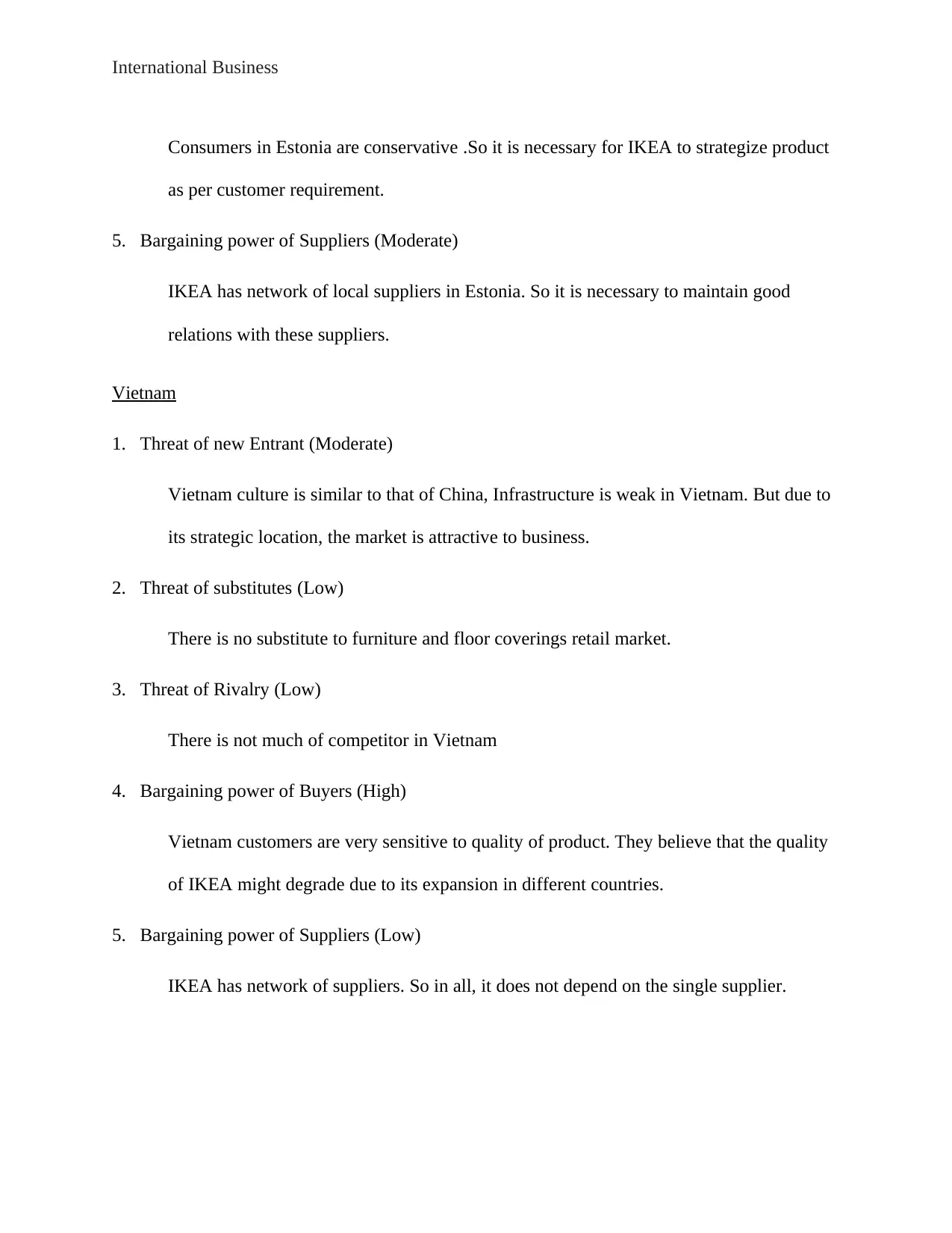
International Business
Consumers in Estonia are conservative .So it is necessary for IKEA to strategize product
as per customer requirement.
5. Bargaining power of Suppliers (Moderate)
IKEA has network of local suppliers in Estonia. So it is necessary to maintain good
relations with these suppliers.
Vietnam
1. Threat of new Entrant (Moderate)
Vietnam culture is similar to that of China, Infrastructure is weak in Vietnam. But due to
its strategic location, the market is attractive to business.
2. Threat of substitutes (Low)
There is no substitute to furniture and floor coverings retail market.
3. Threat of Rivalry (Low)
There is not much of competitor in Vietnam
4. Bargaining power of Buyers (High)
Vietnam customers are very sensitive to quality of product. They believe that the quality
of IKEA might degrade due to its expansion in different countries.
5. Bargaining power of Suppliers (Low)
IKEA has network of suppliers. So in all, it does not depend on the single supplier.
Consumers in Estonia are conservative .So it is necessary for IKEA to strategize product
as per customer requirement.
5. Bargaining power of Suppliers (Moderate)
IKEA has network of local suppliers in Estonia. So it is necessary to maintain good
relations with these suppliers.
Vietnam
1. Threat of new Entrant (Moderate)
Vietnam culture is similar to that of China, Infrastructure is weak in Vietnam. But due to
its strategic location, the market is attractive to business.
2. Threat of substitutes (Low)
There is no substitute to furniture and floor coverings retail market.
3. Threat of Rivalry (Low)
There is not much of competitor in Vietnam
4. Bargaining power of Buyers (High)
Vietnam customers are very sensitive to quality of product. They believe that the quality
of IKEA might degrade due to its expansion in different countries.
5. Bargaining power of Suppliers (Low)
IKEA has network of suppliers. So in all, it does not depend on the single supplier.
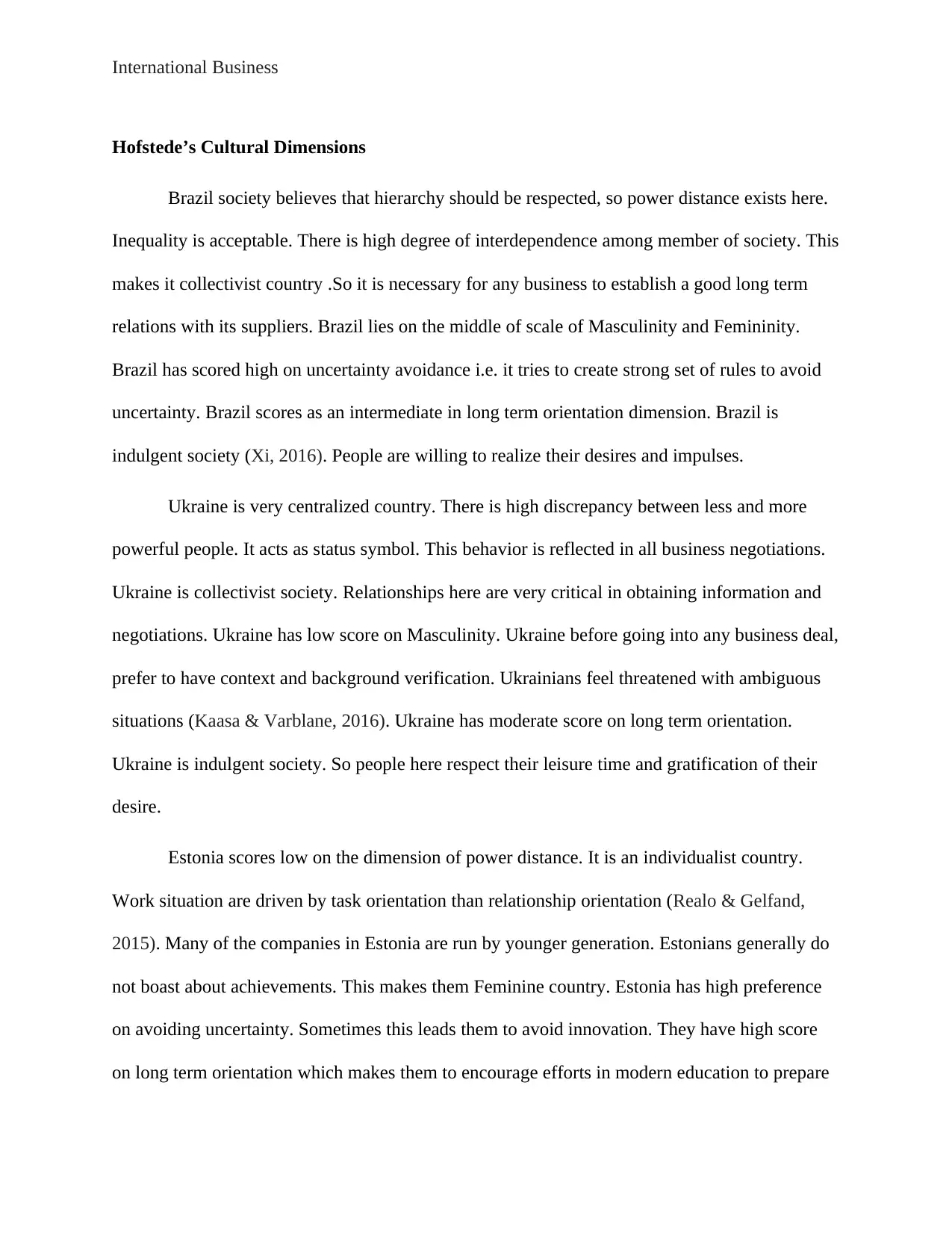
International Business
Hofstede’s Cultural Dimensions
Brazil society believes that hierarchy should be respected, so power distance exists here.
Inequality is acceptable. There is high degree of interdependence among member of society. This
makes it collectivist country .So it is necessary for any business to establish a good long term
relations with its suppliers. Brazil lies on the middle of scale of Masculinity and Femininity.
Brazil has scored high on uncertainty avoidance i.e. it tries to create strong set of rules to avoid
uncertainty. Brazil scores as an intermediate in long term orientation dimension. Brazil is
indulgent society (Xi, 2016). People are willing to realize their desires and impulses.
Ukraine is very centralized country. There is high discrepancy between less and more
powerful people. It acts as status symbol. This behavior is reflected in all business negotiations.
Ukraine is collectivist society. Relationships here are very critical in obtaining information and
negotiations. Ukraine has low score on Masculinity. Ukraine before going into any business deal,
prefer to have context and background verification. Ukrainians feel threatened with ambiguous
situations (Kaasa & Varblane, 2016). Ukraine has moderate score on long term orientation.
Ukraine is indulgent society. So people here respect their leisure time and gratification of their
desire.
Estonia scores low on the dimension of power distance. It is an individualist country.
Work situation are driven by task orientation than relationship orientation (Realo & Gelfand,
2015). Many of the companies in Estonia are run by younger generation. Estonians generally do
not boast about achievements. This makes them Feminine country. Estonia has high preference
on avoiding uncertainty. Sometimes this leads them to avoid innovation. They have high score
on long term orientation which makes them to encourage efforts in modern education to prepare
Hofstede’s Cultural Dimensions
Brazil society believes that hierarchy should be respected, so power distance exists here.
Inequality is acceptable. There is high degree of interdependence among member of society. This
makes it collectivist country .So it is necessary for any business to establish a good long term
relations with its suppliers. Brazil lies on the middle of scale of Masculinity and Femininity.
Brazil has scored high on uncertainty avoidance i.e. it tries to create strong set of rules to avoid
uncertainty. Brazil scores as an intermediate in long term orientation dimension. Brazil is
indulgent society (Xi, 2016). People are willing to realize their desires and impulses.
Ukraine is very centralized country. There is high discrepancy between less and more
powerful people. It acts as status symbol. This behavior is reflected in all business negotiations.
Ukraine is collectivist society. Relationships here are very critical in obtaining information and
negotiations. Ukraine has low score on Masculinity. Ukraine before going into any business deal,
prefer to have context and background verification. Ukrainians feel threatened with ambiguous
situations (Kaasa & Varblane, 2016). Ukraine has moderate score on long term orientation.
Ukraine is indulgent society. So people here respect their leisure time and gratification of their
desire.
Estonia scores low on the dimension of power distance. It is an individualist country.
Work situation are driven by task orientation than relationship orientation (Realo & Gelfand,
2015). Many of the companies in Estonia are run by younger generation. Estonians generally do
not boast about achievements. This makes them Feminine country. Estonia has high preference
on avoiding uncertainty. Sometimes this leads them to avoid innovation. They have high score
on long term orientation which makes them to encourage efforts in modern education to prepare
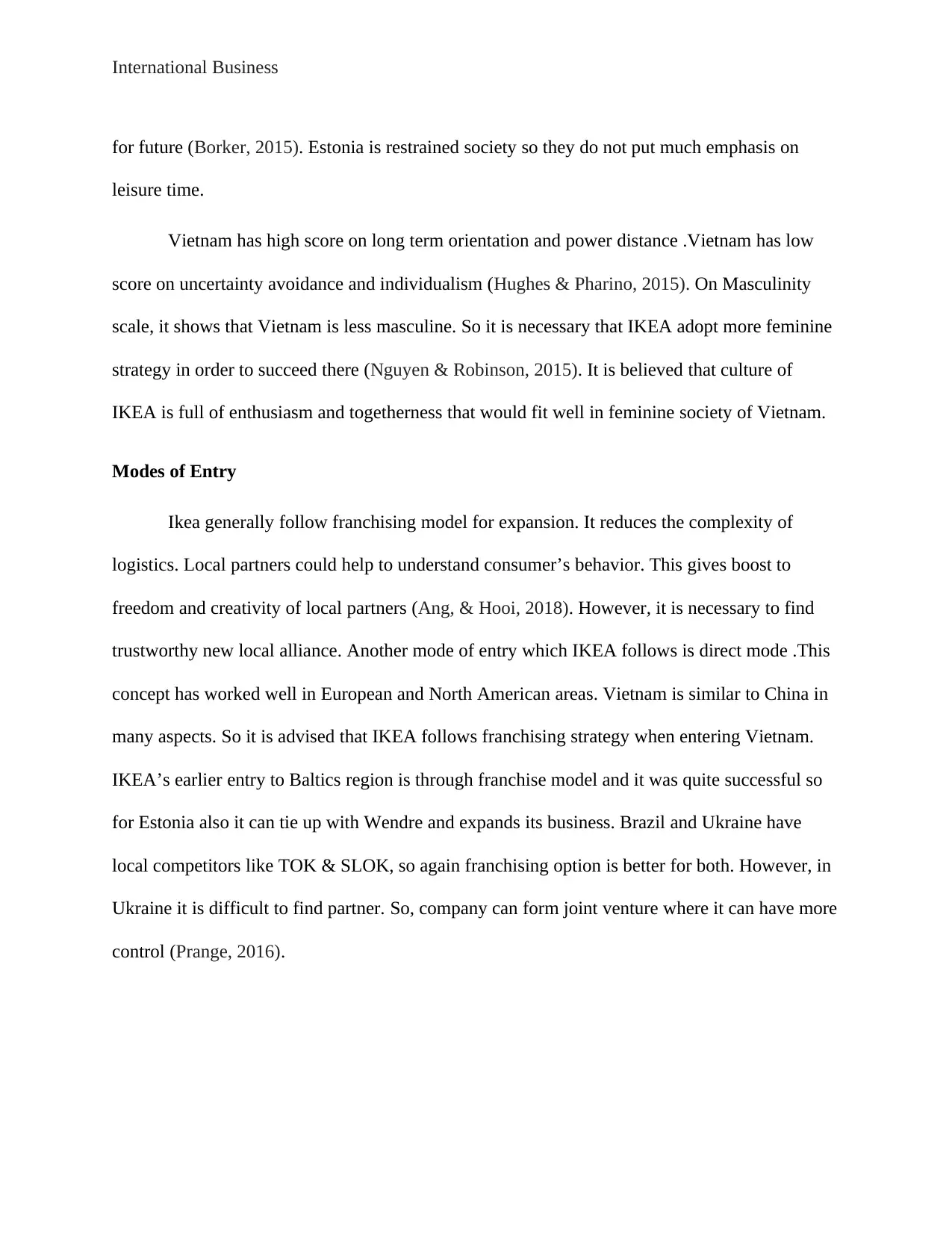
International Business
for future (Borker, 2015). Estonia is restrained society so they do not put much emphasis on
leisure time.
Vietnam has high score on long term orientation and power distance .Vietnam has low
score on uncertainty avoidance and individualism (Hughes & Pharino, 2015). On Masculinity
scale, it shows that Vietnam is less masculine. So it is necessary that IKEA adopt more feminine
strategy in order to succeed there (Nguyen & Robinson, 2015). It is believed that culture of
IKEA is full of enthusiasm and togetherness that would fit well in feminine society of Vietnam.
Modes of Entry
Ikea generally follow franchising model for expansion. It reduces the complexity of
logistics. Local partners could help to understand consumer’s behavior. This gives boost to
freedom and creativity of local partners (Ang, & Hooi, 2018). However, it is necessary to find
trustworthy new local alliance. Another mode of entry which IKEA follows is direct mode .This
concept has worked well in European and North American areas. Vietnam is similar to China in
many aspects. So it is advised that IKEA follows franchising strategy when entering Vietnam.
IKEA’s earlier entry to Baltics region is through franchise model and it was quite successful so
for Estonia also it can tie up with Wendre and expands its business. Brazil and Ukraine have
local competitors like TOK & SLOK, so again franchising option is better for both. However, in
Ukraine it is difficult to find partner. So, company can form joint venture where it can have more
control (Prange, 2016).
for future (Borker, 2015). Estonia is restrained society so they do not put much emphasis on
leisure time.
Vietnam has high score on long term orientation and power distance .Vietnam has low
score on uncertainty avoidance and individualism (Hughes & Pharino, 2015). On Masculinity
scale, it shows that Vietnam is less masculine. So it is necessary that IKEA adopt more feminine
strategy in order to succeed there (Nguyen & Robinson, 2015). It is believed that culture of
IKEA is full of enthusiasm and togetherness that would fit well in feminine society of Vietnam.
Modes of Entry
Ikea generally follow franchising model for expansion. It reduces the complexity of
logistics. Local partners could help to understand consumer’s behavior. This gives boost to
freedom and creativity of local partners (Ang, & Hooi, 2018). However, it is necessary to find
trustworthy new local alliance. Another mode of entry which IKEA follows is direct mode .This
concept has worked well in European and North American areas. Vietnam is similar to China in
many aspects. So it is advised that IKEA follows franchising strategy when entering Vietnam.
IKEA’s earlier entry to Baltics region is through franchise model and it was quite successful so
for Estonia also it can tie up with Wendre and expands its business. Brazil and Ukraine have
local competitors like TOK & SLOK, so again franchising option is better for both. However, in
Ukraine it is difficult to find partner. So, company can form joint venture where it can have more
control (Prange, 2016).
Secure Best Marks with AI Grader
Need help grading? Try our AI Grader for instant feedback on your assignments.
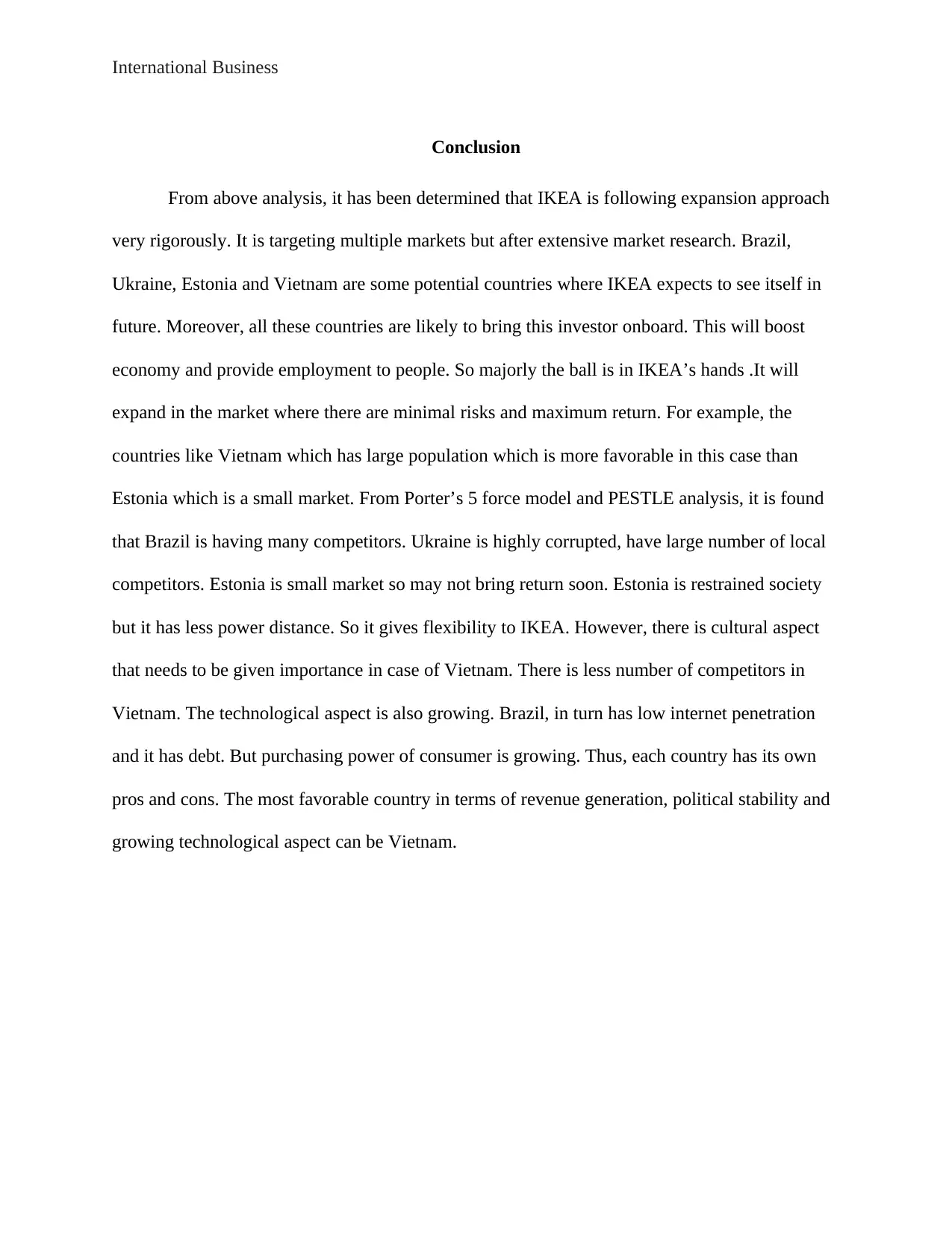
International Business
Conclusion
From above analysis, it has been determined that IKEA is following expansion approach
very rigorously. It is targeting multiple markets but after extensive market research. Brazil,
Ukraine, Estonia and Vietnam are some potential countries where IKEA expects to see itself in
future. Moreover, all these countries are likely to bring this investor onboard. This will boost
economy and provide employment to people. So majorly the ball is in IKEA’s hands .It will
expand in the market where there are minimal risks and maximum return. For example, the
countries like Vietnam which has large population which is more favorable in this case than
Estonia which is a small market. From Porter’s 5 force model and PESTLE analysis, it is found
that Brazil is having many competitors. Ukraine is highly corrupted, have large number of local
competitors. Estonia is small market so may not bring return soon. Estonia is restrained society
but it has less power distance. So it gives flexibility to IKEA. However, there is cultural aspect
that needs to be given importance in case of Vietnam. There is less number of competitors in
Vietnam. The technological aspect is also growing. Brazil, in turn has low internet penetration
and it has debt. But purchasing power of consumer is growing. Thus, each country has its own
pros and cons. The most favorable country in terms of revenue generation, political stability and
growing technological aspect can be Vietnam.
Conclusion
From above analysis, it has been determined that IKEA is following expansion approach
very rigorously. It is targeting multiple markets but after extensive market research. Brazil,
Ukraine, Estonia and Vietnam are some potential countries where IKEA expects to see itself in
future. Moreover, all these countries are likely to bring this investor onboard. This will boost
economy and provide employment to people. So majorly the ball is in IKEA’s hands .It will
expand in the market where there are minimal risks and maximum return. For example, the
countries like Vietnam which has large population which is more favorable in this case than
Estonia which is a small market. From Porter’s 5 force model and PESTLE analysis, it is found
that Brazil is having many competitors. Ukraine is highly corrupted, have large number of local
competitors. Estonia is small market so may not bring return soon. Estonia is restrained society
but it has less power distance. So it gives flexibility to IKEA. However, there is cultural aspect
that needs to be given importance in case of Vietnam. There is less number of competitors in
Vietnam. The technological aspect is also growing. Brazil, in turn has low internet penetration
and it has debt. But purchasing power of consumer is growing. Thus, each country has its own
pros and cons. The most favorable country in terms of revenue generation, political stability and
growing technological aspect can be Vietnam.
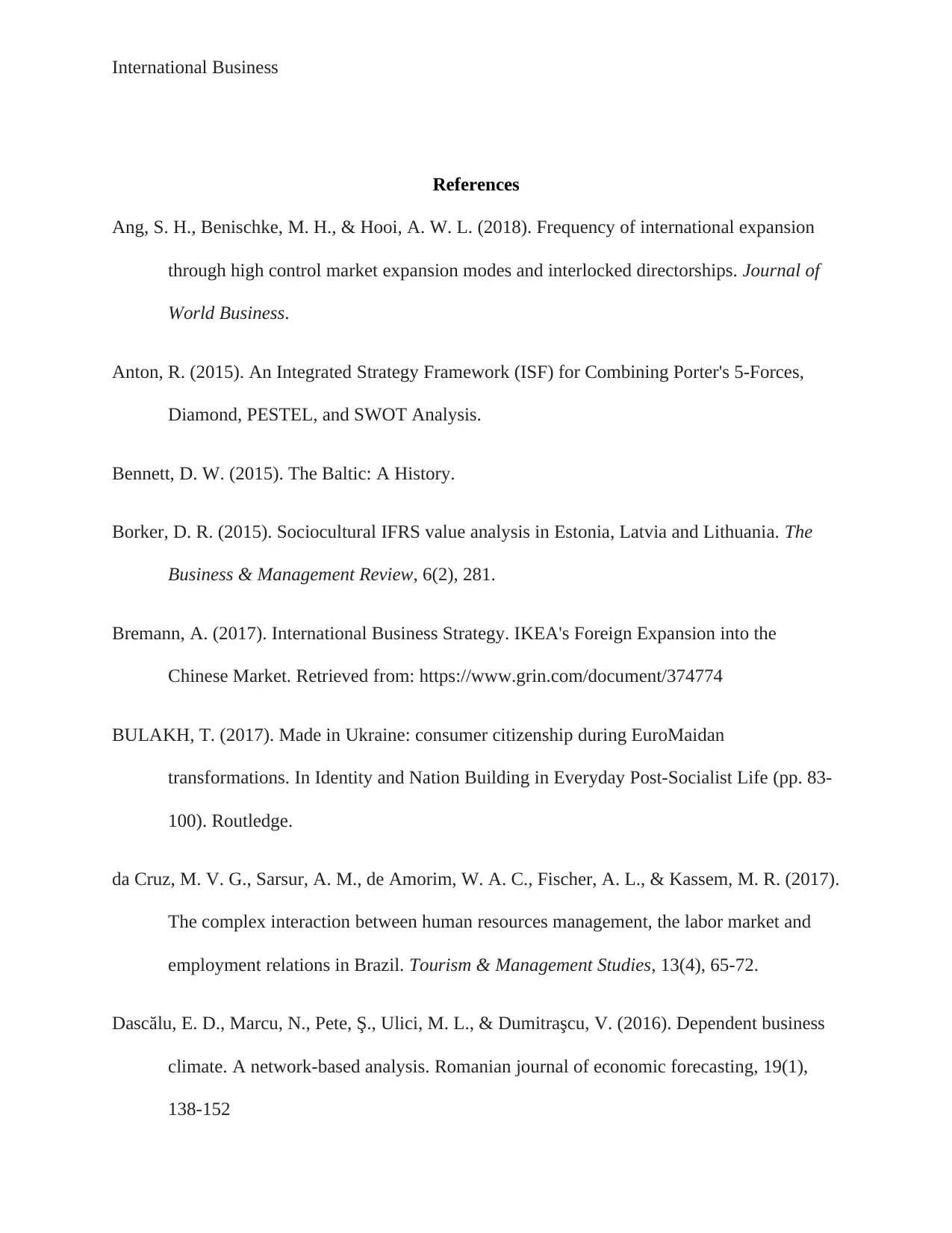
International Business
References
Ang, S. H., Benischke, M. H., & Hooi, A. W. L. (2018). Frequency of international expansion
through high control market expansion modes and interlocked directorships. Journal of
World Business.
Anton, R. (2015). An Integrated Strategy Framework (ISF) for Combining Porter's 5-Forces,
Diamond, PESTEL, and SWOT Analysis.
Bennett, D. W. (2015). The Baltic: A History.
Borker, D. R. (2015). Sociocultural IFRS value analysis in Estonia, Latvia and Lithuania. The
Business & Management Review, 6(2), 281.
Bremann, A. (2017). International Business Strategy. IKEA's Foreign Expansion into the
Chinese Market. Retrieved from: https://www.grin.com/document/374774
BULAKH, T. (2017). Made in Ukraine: consumer citizenship during EuroMaidan
transformations. In Identity and Nation Building in Everyday Post-Socialist Life (pp. 83-
100). Routledge.
da Cruz, M. V. G., Sarsur, A. M., de Amorim, W. A. C., Fischer, A. L., & Kassem, M. R. (2017).
The complex interaction between human resources management, the labor market and
employment relations in Brazil. Tourism & Management Studies, 13(4), 65-72.
Dascălu, E. D., Marcu, N., Pete, Ş., Ulici, M. L., & Dumitraşcu, V. (2016). Dependent business
climate. A network-based analysis. Romanian journal of economic forecasting, 19(1),
138-152
References
Ang, S. H., Benischke, M. H., & Hooi, A. W. L. (2018). Frequency of international expansion
through high control market expansion modes and interlocked directorships. Journal of
World Business.
Anton, R. (2015). An Integrated Strategy Framework (ISF) for Combining Porter's 5-Forces,
Diamond, PESTEL, and SWOT Analysis.
Bennett, D. W. (2015). The Baltic: A History.
Borker, D. R. (2015). Sociocultural IFRS value analysis in Estonia, Latvia and Lithuania. The
Business & Management Review, 6(2), 281.
Bremann, A. (2017). International Business Strategy. IKEA's Foreign Expansion into the
Chinese Market. Retrieved from: https://www.grin.com/document/374774
BULAKH, T. (2017). Made in Ukraine: consumer citizenship during EuroMaidan
transformations. In Identity and Nation Building in Everyday Post-Socialist Life (pp. 83-
100). Routledge.
da Cruz, M. V. G., Sarsur, A. M., de Amorim, W. A. C., Fischer, A. L., & Kassem, M. R. (2017).
The complex interaction between human resources management, the labor market and
employment relations in Brazil. Tourism & Management Studies, 13(4), 65-72.
Dascălu, E. D., Marcu, N., Pete, Ş., Ulici, M. L., & Dumitraşcu, V. (2016). Dependent business
climate. A network-based analysis. Romanian journal of economic forecasting, 19(1),
138-152
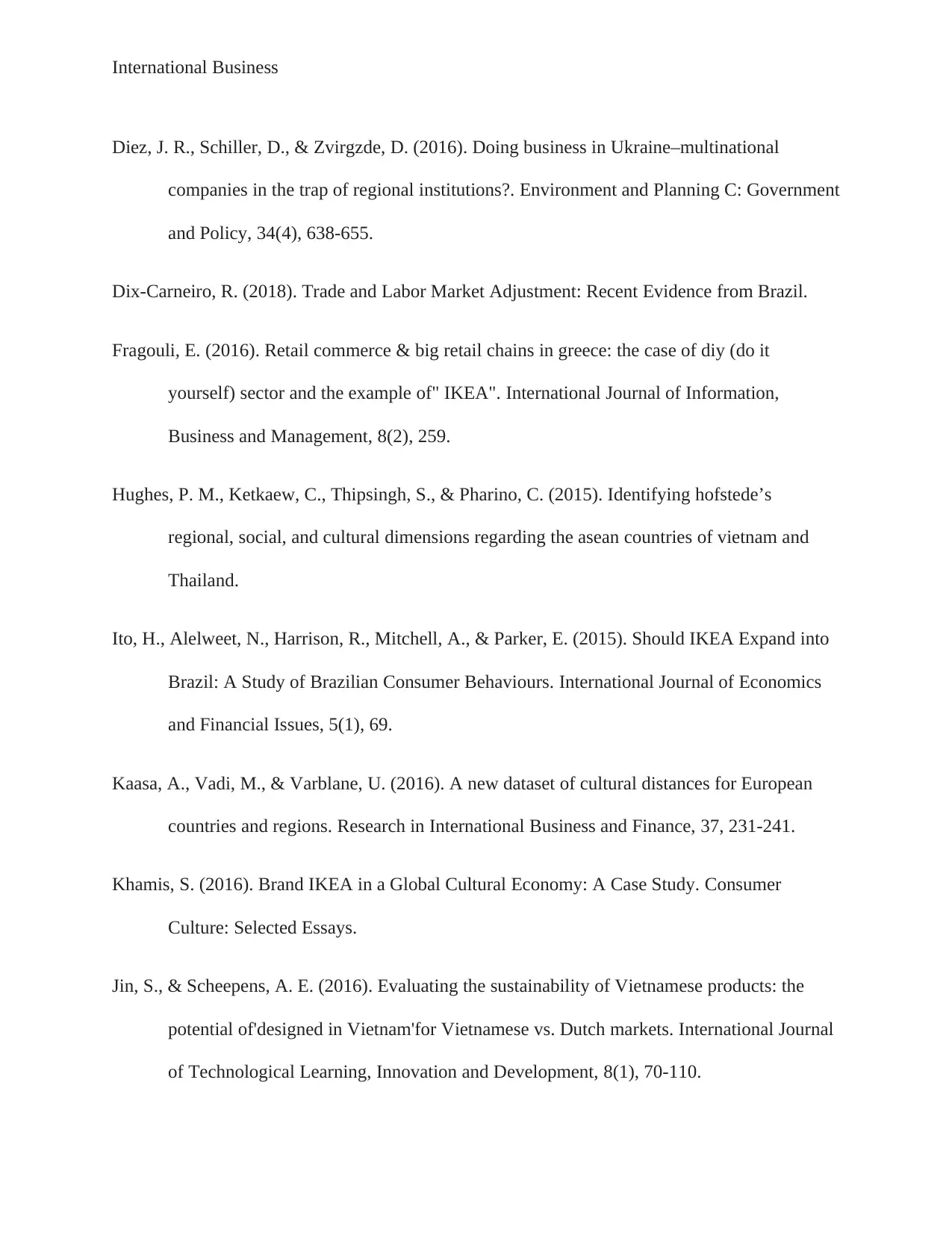
International Business
Diez, J. R., Schiller, D., & Zvirgzde, D. (2016). Doing business in Ukraine–multinational
companies in the trap of regional institutions?. Environment and Planning C: Government
and Policy, 34(4), 638-655.
Dix-Carneiro, R. (2018). Trade and Labor Market Adjustment: Recent Evidence from Brazil.
Fragouli, E. (2016). Retail commerce & big retail chains in greece: the case of diy (do it
yourself) sector and the example of" IKEA". International Journal of Information,
Business and Management, 8(2), 259.
Hughes, P. M., Ketkaew, C., Thipsingh, S., & Pharino, C. (2015). Identifying hofstede’s
regional, social, and cultural dimensions regarding the asean countries of vietnam and
Thailand.
Ito, H., Alelweet, N., Harrison, R., Mitchell, A., & Parker, E. (2015). Should IKEA Expand into
Brazil: A Study of Brazilian Consumer Behaviours. International Journal of Economics
and Financial Issues, 5(1), 69.
Kaasa, A., Vadi, M., & Varblane, U. (2016). A new dataset of cultural distances for European
countries and regions. Research in International Business and Finance, 37, 231-241.
Khamis, S. (2016). Brand IKEA in a Global Cultural Economy: A Case Study. Consumer
Culture: Selected Essays.
Jin, S., & Scheepens, A. E. (2016). Evaluating the sustainability of Vietnamese products: the
potential of'designed in Vietnam'for Vietnamese vs. Dutch markets. International Journal
of Technological Learning, Innovation and Development, 8(1), 70-110.
Diez, J. R., Schiller, D., & Zvirgzde, D. (2016). Doing business in Ukraine–multinational
companies in the trap of regional institutions?. Environment and Planning C: Government
and Policy, 34(4), 638-655.
Dix-Carneiro, R. (2018). Trade and Labor Market Adjustment: Recent Evidence from Brazil.
Fragouli, E. (2016). Retail commerce & big retail chains in greece: the case of diy (do it
yourself) sector and the example of" IKEA". International Journal of Information,
Business and Management, 8(2), 259.
Hughes, P. M., Ketkaew, C., Thipsingh, S., & Pharino, C. (2015). Identifying hofstede’s
regional, social, and cultural dimensions regarding the asean countries of vietnam and
Thailand.
Ito, H., Alelweet, N., Harrison, R., Mitchell, A., & Parker, E. (2015). Should IKEA Expand into
Brazil: A Study of Brazilian Consumer Behaviours. International Journal of Economics
and Financial Issues, 5(1), 69.
Kaasa, A., Vadi, M., & Varblane, U. (2016). A new dataset of cultural distances for European
countries and regions. Research in International Business and Finance, 37, 231-241.
Khamis, S. (2016). Brand IKEA in a Global Cultural Economy: A Case Study. Consumer
Culture: Selected Essays.
Jin, S., & Scheepens, A. E. (2016). Evaluating the sustainability of Vietnamese products: the
potential of'designed in Vietnam'for Vietnamese vs. Dutch markets. International Journal
of Technological Learning, Innovation and Development, 8(1), 70-110.
Paraphrase This Document
Need a fresh take? Get an instant paraphrase of this document with our AI Paraphraser
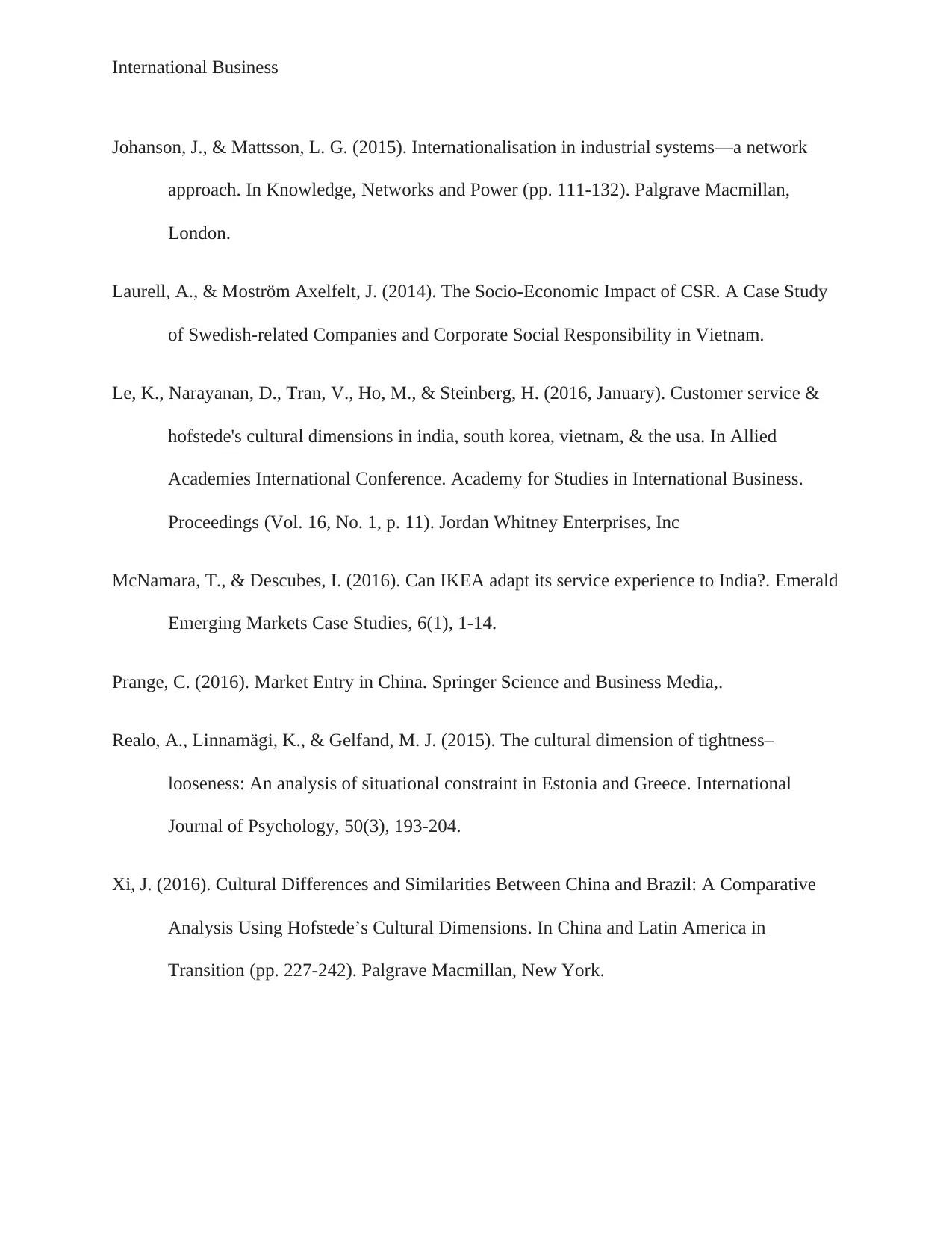
International Business
Johanson, J., & Mattsson, L. G. (2015). Internationalisation in industrial systems—a network
approach. In Knowledge, Networks and Power (pp. 111-132). Palgrave Macmillan,
London.
Laurell, A., & Moström Axelfelt, J. (2014). The Socio-Economic Impact of CSR. A Case Study
of Swedish-related Companies and Corporate Social Responsibility in Vietnam.
Le, K., Narayanan, D., Tran, V., Ho, M., & Steinberg, H. (2016, January). Customer service &
hofstede's cultural dimensions in india, south korea, vietnam, & the usa. In Allied
Academies International Conference. Academy for Studies in International Business.
Proceedings (Vol. 16, No. 1, p. 11). Jordan Whitney Enterprises, Inc
McNamara, T., & Descubes, I. (2016). Can IKEA adapt its service experience to India?. Emerald
Emerging Markets Case Studies, 6(1), 1-14.
Prange, C. (2016). Market Entry in China. Springer Science and Business Media,.
Realo, A., Linnamägi, K., & Gelfand, M. J. (2015). The cultural dimension of tightness–
looseness: An analysis of situational constraint in Estonia and Greece. International
Journal of Psychology, 50(3), 193-204.
Xi, J. (2016). Cultural Differences and Similarities Between China and Brazil: A Comparative
Analysis Using Hofstede’s Cultural Dimensions. In China and Latin America in
Transition (pp. 227-242). Palgrave Macmillan, New York.
Johanson, J., & Mattsson, L. G. (2015). Internationalisation in industrial systems—a network
approach. In Knowledge, Networks and Power (pp. 111-132). Palgrave Macmillan,
London.
Laurell, A., & Moström Axelfelt, J. (2014). The Socio-Economic Impact of CSR. A Case Study
of Swedish-related Companies and Corporate Social Responsibility in Vietnam.
Le, K., Narayanan, D., Tran, V., Ho, M., & Steinberg, H. (2016, January). Customer service &
hofstede's cultural dimensions in india, south korea, vietnam, & the usa. In Allied
Academies International Conference. Academy for Studies in International Business.
Proceedings (Vol. 16, No. 1, p. 11). Jordan Whitney Enterprises, Inc
McNamara, T., & Descubes, I. (2016). Can IKEA adapt its service experience to India?. Emerald
Emerging Markets Case Studies, 6(1), 1-14.
Prange, C. (2016). Market Entry in China. Springer Science and Business Media,.
Realo, A., Linnamägi, K., & Gelfand, M. J. (2015). The cultural dimension of tightness–
looseness: An analysis of situational constraint in Estonia and Greece. International
Journal of Psychology, 50(3), 193-204.
Xi, J. (2016). Cultural Differences and Similarities Between China and Brazil: A Comparative
Analysis Using Hofstede’s Cultural Dimensions. In China and Latin America in
Transition (pp. 227-242). Palgrave Macmillan, New York.
1 out of 20
Related Documents
Your All-in-One AI-Powered Toolkit for Academic Success.
+13062052269
info@desklib.com
Available 24*7 on WhatsApp / Email
![[object Object]](/_next/static/media/star-bottom.7253800d.svg)
Unlock your academic potential
© 2024 | Zucol Services PVT LTD | All rights reserved.




